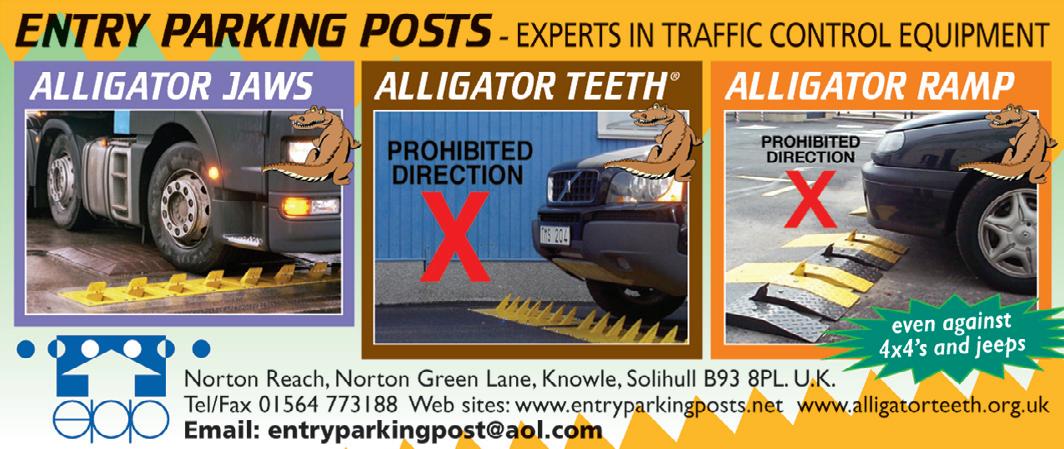LOOKING FORWARD






Election considerations are turning traffic and air quality plans into a political football
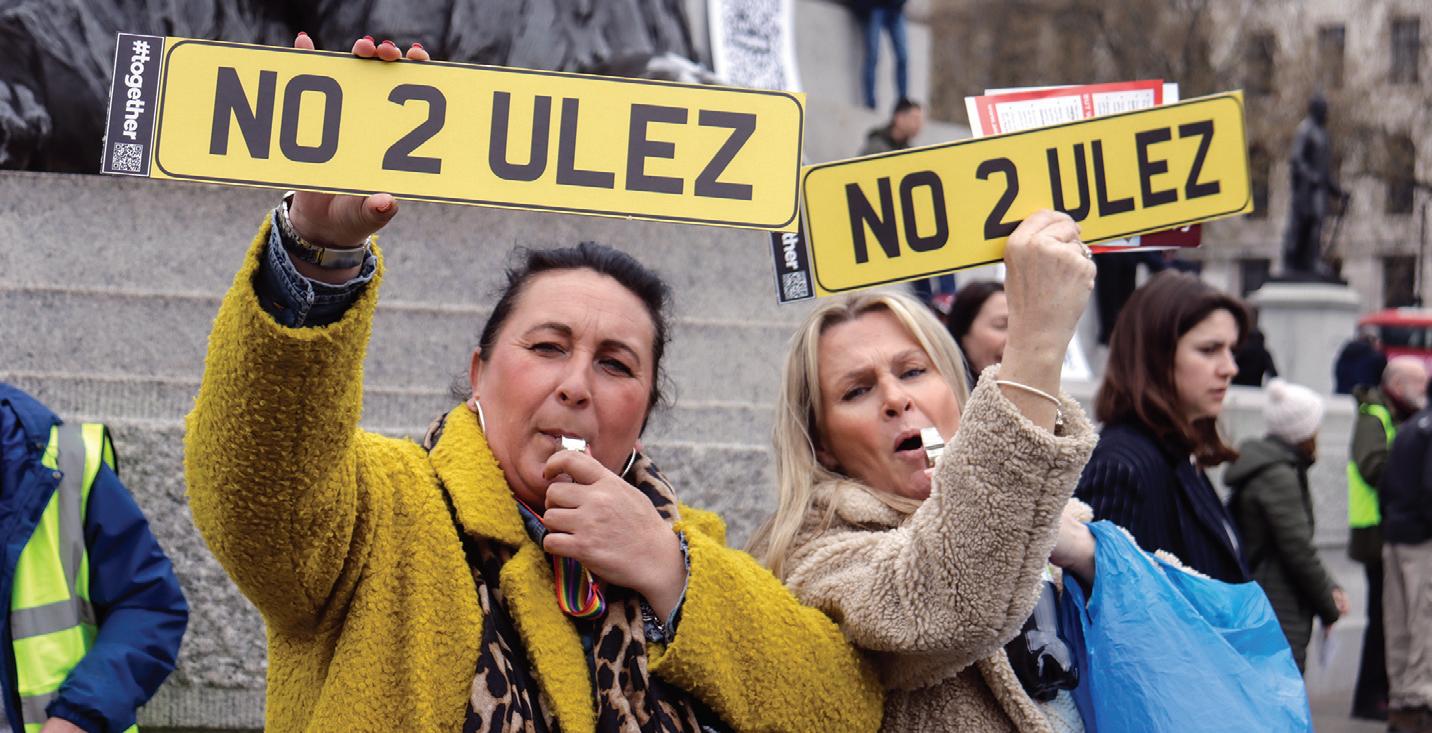







Election considerations are turning traffic and air quality plans into a political football



The wafer thin 495 votes majority that saw the Conservatives retain Boris Johnson’s Uxbridge and South Ruislip constituency in a byelection was widely attributed to the successful Tory candidate aligning himself with the anxieties felt by some locals around the perceived negative impact of the expansion of the Ultra Low Emission Zone (ULEZ) into outer London boroughs.
Prime Minister Rishi Sunak detects a route to retaining power in the next general election by taking the side of those who regard traffic management schemes as a kerb on their rights or an unwelcome extra cost in straightened times. Sunak has announced a review of low traffic neighbourhoods (LTNs) and accused the Labour Party of being “anti-motorist”. This approach makes sense in the world of party politics, but ignores the fact that it was Johnson’s government that promoted (or at least enabled) measures that encourage active travel, reduce car dependency, improve road safety and reduce air pollution.
Party politics mean that the Opposition, which is banking on election wins in outer London, is now recalibrating its position on kerbing traffic-related emissions. The Labour leadership has been leaning on the Mayor of London to change tack on ULEZ, but Sadiq Khan appears not to be for turning.

Meanwhile, on the Conservative side there remain some voices committed to the net zero agenda who appear to unimpressed with the PM’s tactical ploys.
Hopefully, once election fever passes, we can have a sensible, civil and factbased conversation about air quality and traffic management.
Mark Moran Editor
15 NOVEMBER 2023
Traffic and parking teams are the people who keep our towns and cities moving. They keep our towns and cities moving. By reducing traffic congestion, ensuring the free movement of public transport and safety of pedestrians, these teams ensure residents, shoppers, businesses, disabled people and the emergency services have equitable access safe and sufficient parking and loading facilities at destinations.
Traffic + Parking 2023 provides a space where local authorities and their partners can share best practice, keep up-to-date on policy changes and see the latest innovations in systems and services first hand.

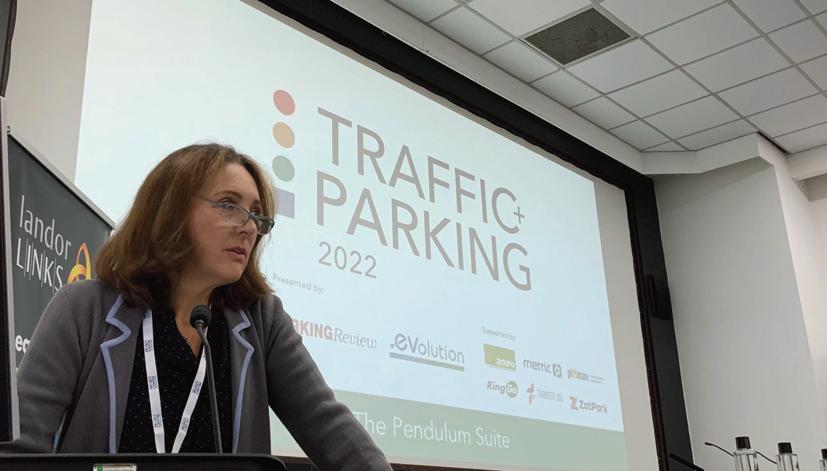

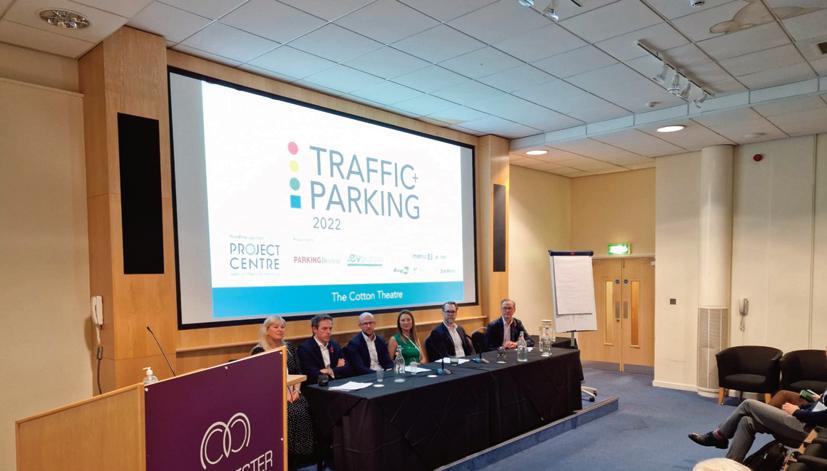

Presented by:
Who will be attending Traffic + Parking 2023
l Local authority officers
l Councillors and stakeholders
l Parking operators and contractors


l System and service suppliers


l EV charging specialists




l Shared mobility and car club providers

l Academics and researchers
l Consultants

l Campaigners
Public Sector ticket FREE*
Private Sector ticket £245 + VAT

Third Sector ticket £95 + VAT







*please visit the website for full terms and conditions
Exhibition now sold out!
Exhibitors include:
Parking professionals gathered in Newcastle for a day of debate and networking at the North East Parking Show

Stuart Harrison sets out his vision for his year in office as the British Parking Association’s new president

The British Parking Association is championing equality, diversity and inclusivity in the sector’s workforce
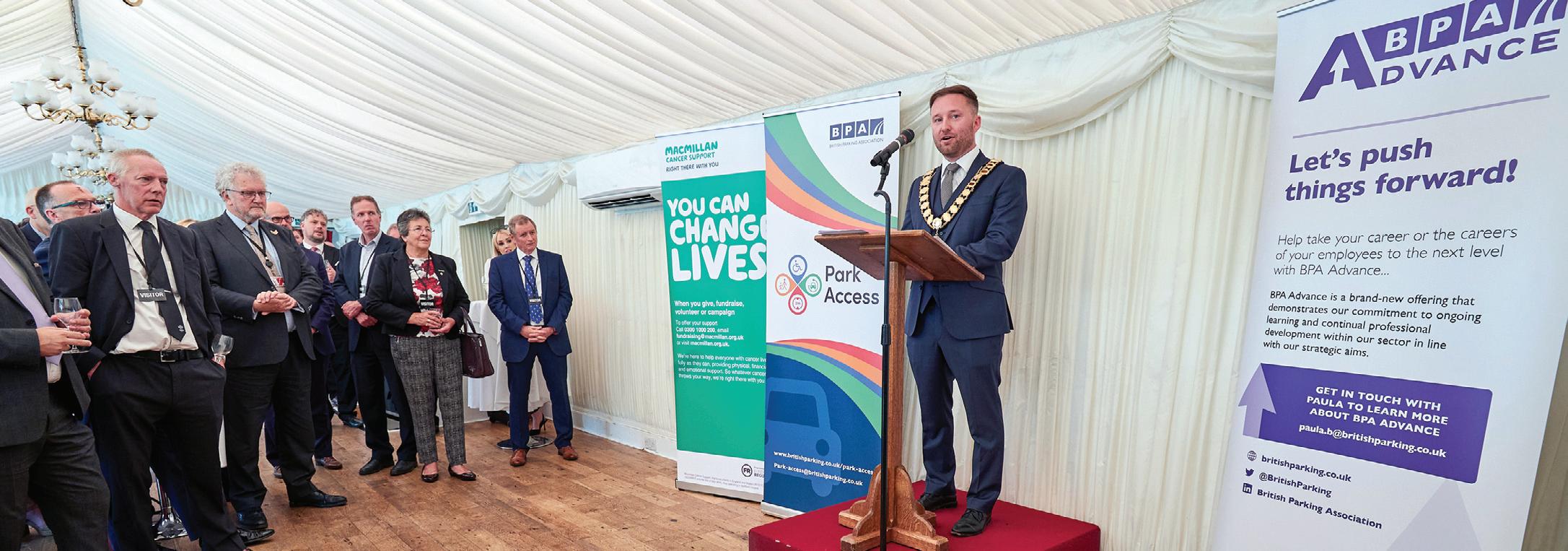
The Local Government Information Unit says councils are open to using technology to deliver progressive parking policies
The Institution of Structural Engineers’ Car Park Design offers architects, engineers and developers up-to-date advice

How to tackle EV fires, mapping public charging provision and BT’s plan to convert obsolete cabinets into chargers
Sara Sloman looks at how hospital and university parking managers can make EV charging fit for a wide range of users
Parking is part of the mix in Transport for the West Midlands’s latest bid to launch a regional Mobility as a Service app
The Finalists Centre pages
Editorial
Managing editor: Mark Moran Tel: 020 7091 7871
mark.moran@landor.co.uk
Deputy editor: Deniz Huseyin Tel: 020 7091 7872
deniz.huseyin@landor.co.uk
Editorial director: Peter Stonham
Production and design production@landor.co.uk
Advertising, sponsorship, marketing and exhibition packages Jason Conboy Tel: 020 7091 7895 jason@landor.co.uk
Subscriptions Christina Pierre Tel: 020 7091 7959 subs@landor.co.uk Accounts Irina Cocks Tel: 020 7091 7854 irina.cocks@landor.co.uk Managing Director
ISSN:

A byelection defined by a fight over a low emission scheme is redrawing the national political battleground, writes Peter
StonhamPrime Minister Rishi Sunak has ordered the Department for Transport (DfT) to undertake a review of low traffic neighbourhoods (LTNs) in England, saying that he is on the side of drivers and was supporting people to “use their cars to do all the things that matter to them”, as he told the Sunday Telegraph. The review will only look at LTNs in England, as they are a devolved matter in Scotland, Wales and Northern Ireland.
The move comes in the wake of the Uxbridge and South Ruislip byelection, which the Conservatives held to some surprise, and which has led to intense political discussion about the influence on the vote of the extension of the London Ultra Low Emission (ULEZ) zone to the outer boroughs, including the area of the constituency. Meanwhile, last month the High Court rejected a legal challenge to the ULEZ expansion by five local authorities. The judges dismissed the councils’ case, saying the mayor’s expansion decision was “within his powers”.
However, speaking after the court decision, Sunak said “banning things and stopping people from doing things is not the right approach” to reaching net zero. He said the government would strive to meet the net zero target without “unnecessarily adding costs and burdens to families, particularly at a time like now when the cost of living is a challenge for people with inflation”.
Labour leader, Sir Kier Starmer, has acknowledged the impact of ULEZ on the result and urged the Mayor of London Sadiq Khan to reflect on his decision to press on with the plan.
It all marks a sharpening debate on green policies in the run up to the forthcoming General Election.
LTNs received a boost during the pandemic when the Boris Johnson government supported moves to encourage more walking and cycling locally, along with the aim of reducing traffic, principally by preventing drivers using residential roads as through-routes. They have also been advocated as increasing road safety and reducing localised air pollution. But critics, including some Conservative MPs, argue that they limit the
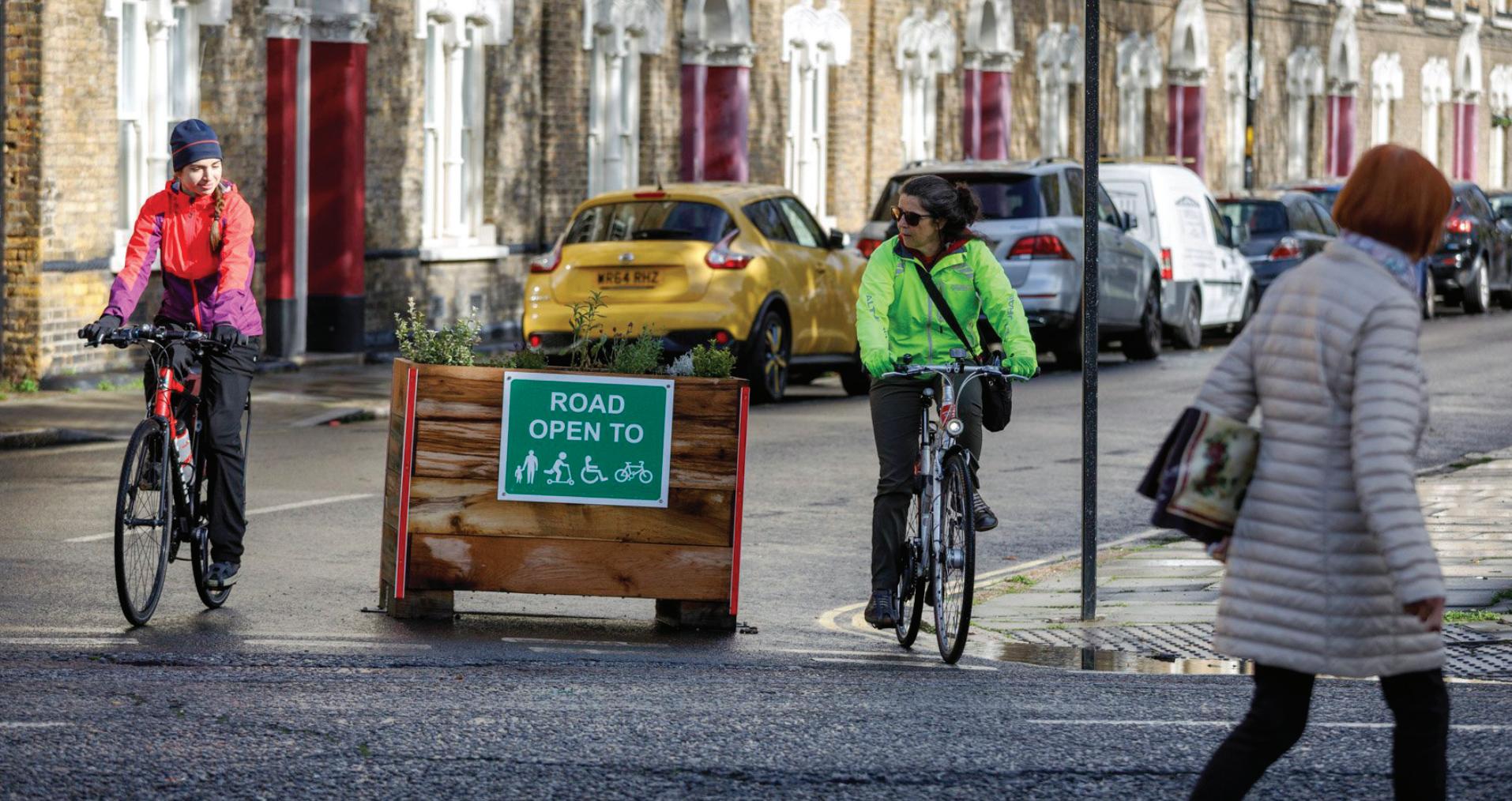
freedom of motorists and push traffic onto other surrounding roads, simply shifting the problem.
In a Sunday Telegraph interview, Sunak said he was not planning to change the deadline for the 2030 ban on the sale of new petrol and diesels cars, despite calls from some Conservatives to do so. It has also been ruled out by Communities and Levelling Up Secretary, Michael Gove. The plan is part of the government’s commitment to achieve net zero by 2050. Sunak pledged “The 2030 target has been our policy for a long time and continues to be – we are not considering a delay to that date.”
However, in a letter to the Prime Minister, a group of 43 Conservative MPs and peers, including Sir Iain Duncan Smith, Sir Jacob Rees-Mogg and David Davis, suggested moving the target to 2035 would avoid “grave harm to the economy”. The letter stated: “The public can only be left worse off by a heavyhanded ban that leaves them unable to purchase the vehicles they want. The future for this country is in imposing fewer burdens and being more lightly regulated than the EU, not in unilaterally imposing additional job-destroying burdens to meet an unnecessary and unworkable deadline.”
In sharp contrast, more than 50 environment groups have also written to the Prime Minister saying they will not “stand by” while politicians use the environment as a “political football”. They are expressing “deep alarm” at reports his government may water down its green commitments. They have requested an urgent meeting with the Prime Minister. The signatories to the letter include Friends of the Earth, Greenpeace UK, the National Trust, RPSCA and RSPB. They say they represent 20 million people. The only signatory directly related to transport appears to be Sustrans. After referencing recent wildfires across the globe, the letter writers say that the environment “remains a central concern for voters” and there is “no public mandate for a delay”.
The letter stated: “It is courage and leadership that we need now. In the past, we have mobilised many of our members collectively with extraordinary results, and our resolve to stand firm now against any and all attacks on this critical policy agenda remains absolute.”
Peter Stonham is editorial director of Landor LINKS

Prime Minister orders review of local traffic neighbourhoods
Rishi Sunak says he has ordered the Department for Transport (DfT) to review how low traffic neighbourhoods (LTNs) are working, but it is not clear whether the government could make councils alter or scrap existing schemes. Earlier this summer, transport secretary Mark Harper announced that the government was stopping the funding of new LTNs in England, with Active Travel England instructed not to help local councils introduce them.

There is speculation that the failure of the DfT to release the long-delayed guidance to local authorities on preparing their next Local Transport Plans may reflect the government’s concern not to be seen to endorse “anti-car” policies.
It is estimated that around 200 LTNs were installed over a twoyear period starting in the COVID-19 pandemic in 2020, with about 50 since scrapped due to local opposition. They have been the subject of strong resistance by some people associating them with the establishment of 15-minute neighbourhoods as a measure to limit freedom of movement through restrictive measures such as barriers, bollards and planters, as well as CCTV.
In his Sunday Telegraph interview, Sunak said: “The vast majority of people in the country use their cars to get around and are dependent on cars. I just want to make sure people know that I’m on their side in supporting them to use their cars to do all the things that matter to them.”
Shadow transport secretary, Louise Haigh, accused the Conservatives of “pure hypocrisy” for accelerating and funding LTNs before denouncing the policy. Haigh said that road safety measures were often demanded by local communities so the decisions must be properly consulted on and made by them.
The Local Government Association (LGA) said the LTN review was “unnecessary” and councils are best placed to make decisions with their communities. It said councils need long-term certainty over funding if they are to help meet the government’s own target of 50% of urban journeys being walked, wheeled or cycled by 2030.



Labour Leader Kier Starmer has blamed the imminent expansion of London’s Ultra Low Emission Zone (ULEZ) for his party’s failure to win the Uxbridge and South Ruislip byelection. He urged Sadiq Khan, London’s Labour mayor, to “reflect” on his decision to extend the zone from the north and south circular roads to cover all London boroughs on 29 August.
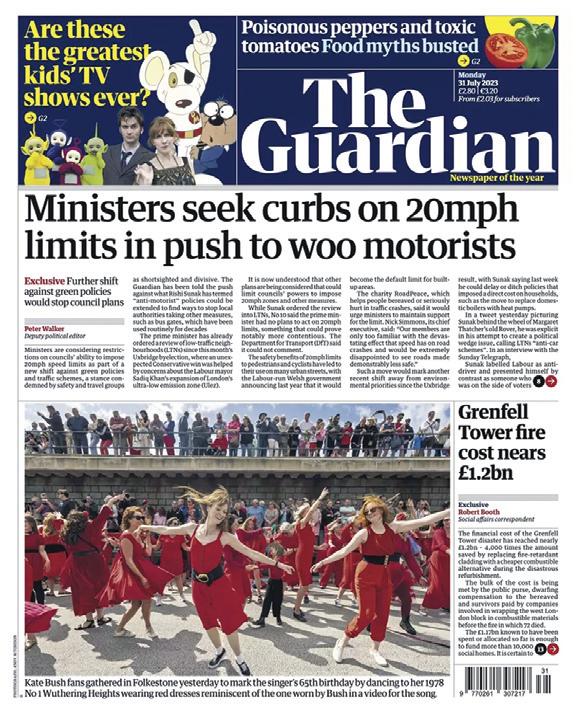
The byelection followed Boris Johnson’s resignation as MP in June after a Commons investigation into whether he misled Parliament over ‘Partygate’. The successful Tory candidate Steve Tuckwell managed to retain the seat by a narrow margin, significantly down on the 7,210 majority that Johnson won the seat in the 2019 General Election. Pre-election leaflets from Tuckwell portrayed himself as the “anti-ULEZ candidate”.
After the election result, Starmer said: “ULEZ was the reason we didn’t win. We know that. We heard that on the doors. And we’ve all got to reflect on that, including the mayor.”
But, after the election result, Sadiq Khan stood by his decision to extend the daily £12.50 charge on cars that do not meet emission standards. He said his decision to expand ULEZ was “difficult” but he could not stand by and do nothing when around 4,000 Londoners die prematurely each year due to air pollution.
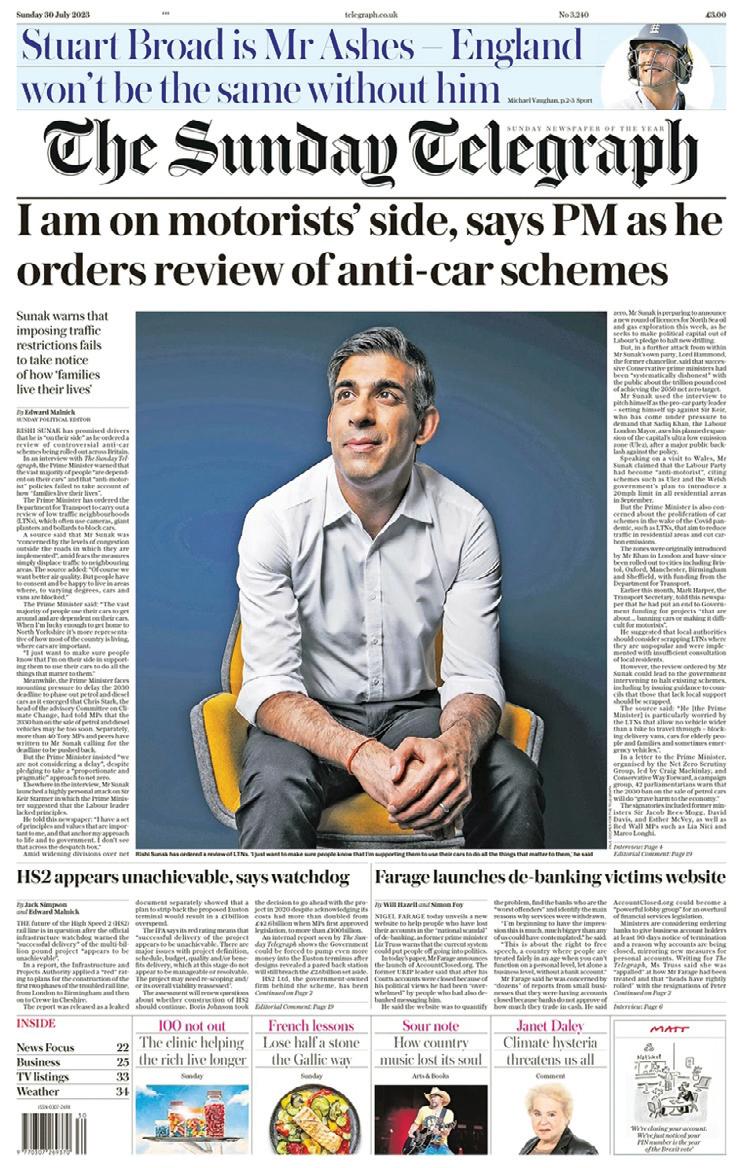
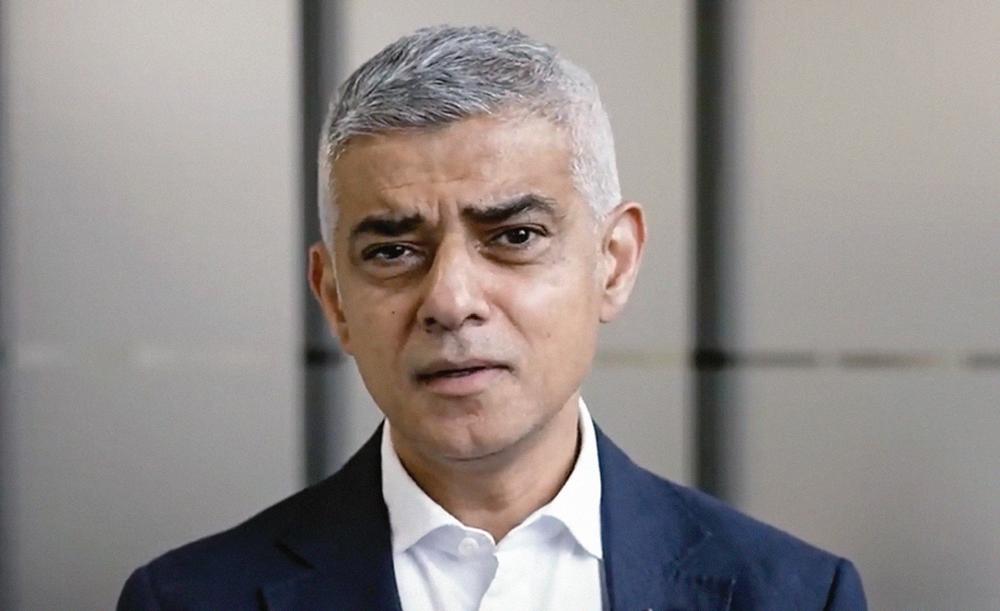
A spokesperson for the mayor said: “Children are growing up with stunted lungs and thousands of people in our city are developing life-changing illnesses, such as cancer, lung disease, dementia and asthma.”
According to Transport for London, 90% of cars driving in outer London are compliant and will not have to pay the charge. “For anyone who is affected, help is available including thousands of pounds for people on low incomes, charities, small businesses, disabled Londoners and anyone in receipt of child benefit,” said the spokesperson. The spokesperson said the mayor would consider “any new ideas for ways to mitigate the impact of expanding the ULEZ” while still tackling air quality and the climate crisis. “He has listened to Londoners throughout this process and continues to do so – and he has already made a number of changes to expand the scrappage eligibility scheme, from the end of this month.”
On 4 August eligibility for the vehicle scrappage scheme was extended to all of London ahead of the expansion ULEZ. Khan announced all Londoners with a non-compliant car can access up to £2,000 to replace their vehicle. Additional support will also be given to small businesses, charities and those with disabilities. Previously only those entitled to means tested benefits could claim money.
Leo Murray, co-director of climate charity Possible, said: “We can’t let basic public health policy be turned into a political football between the two main parties. Polling shows that a majority of Londoners back the ULEZ, and 75% of people in the outer London boroughs opposing ULEZ expansion. There used to be more consensus on this common sense issue. It was former Uxbridge MP Boris Johnson himself who first unfurled ULEZ with fanfare in 2015 when he was Mayor, and the independent Ken Livingstone who brought in the original congestion charge. There’s a way through this where everyone wins. With a fully funded scrappage scheme and investment in cheap, reliable public transport, we can make sure nobody is left behind in the transition to cleaner cities. That means the government of the day must support mayors and councils to clean up our toxic air.”
lans to introduce a workplace parking levy in Bristol have been dropped due to the impact of the rising cost of living. The city’s mayor said now was not the time to impose extra costs on teachers, nurses, and other Bristolians when parking at schools, hospitals and other workplaces. Mayor of Bristol Marvin Rees said: “With high inflation during a national cost-of-living crisis, now is not the time to create more costs for people.”

Rees said that in recent years there have been significant changes in working patterns in the light of both the pandemic and the introduction of a Clean Air Zone in 2021. Rees also cites the lack of progress on introducing a proposed underground transit system in the city as a reason for not introducing the charge.
A workplace parking levy (WPL) charges businesses for employees parking at work in a bid to encourage commuters to use public transport and cut congestion and pollution. Bristol has become the second city to have abandoned a proposed WPL project in the light of economic problems –Leicester having dropped its interest in a scheme in November last year.
The council commissioned the report in 2021 at a cost of £30,000 as a potential option for funding upgrades to the city’s public transport network. The mayor said the feasibility study did not take account of the changing nature of travel in the city. In a blog post called ‘Parking up the wrong tree’, the mayor wrote: “A study was done into the idea of a workplace parking levy, which is lacking any modelling incorporating those major factors for its potential effectiveness. It remains incomplete and with the current stalling of the funding and ambition to take a mass transit system forward we have no plans to introduce this charge.”
The feasibility study was produced for Bristol by Nottingham City Council, a local authority which launched the UK’s first, and so far only, WPL scheme under the Transport Act 2000.


The Nottingham City Council study suggested that a levy in Bristol could raise millions of pounds every year to invest in the city’s public transport. According to the report, it would likely apply to about 9,000 parking spaces at workplaces in Bristol city centre. The report stated: “Bristol City Council is well-positioned to progress with the development of a workplace parking levy,” the report said. “The drive, vision and ambition of Bristol City Council is exciting and will clearly lead to a high-quality, sustainable transport system in Bristol.”
Bristol City Council only published the feasibility study report on 7 August after being ordered to by a tribunal. The council had been contesting a Freedom of Information (FOI) request made by Green Party councillor Ed Plowden asking for the report to be published. The FOI request was repeatedly
Mayor cites cost of living crisis, changing travel patterns and lack of new underground as reasons for dropping parking surcharge
refused by the council and the Information Commissioner, but Cllr Plowden won an appeal to the Information Rights Tribunal.
Posting on X, formerly Twitter, Cllr Plowden said: “Glad that the report has finally been released after I had to get a judge’s order to do so. Sad to see it done with such bad grace when the administration stated in 2021 it should be debated in public. Bristol Greens need time to consider this report, and may well be underwhelmed by it after such a fight to get to see it.”
A key reason cited for dropping the WPL by Rees is a lack of progress on developing an underground mass transit system that he has been advocating for the city.
In his blog post Rees wrote: “When we looked at investing in a mass transit scheme, we identified one potential income stream is a workplace parking levy. This would essentially serve as a surcharge on all drivers parking centrally while they’re at work. It has existed in Nottingham since 2011/12, where the money goes into their tram system (delivered at a time when Bristol could have had one too, had local leaders not fallen out in our region around the millennium).”
In his blog, Rees defended the proposed Bristol underground, stat-
ing that two feasibility studies had shown it to be viable. He wrote: “There has been some sensationalist coverage of a flawed, leaked report that suggests that cost of a mass transit system for our city region is £19bn. In reality, a properly costed plan, where underground is only used in densely populated areas suggests more like £7bn. When London, where most of the tube network is above ground, recently got its most recent mass transit line, the Elizabeth Line, it cost £19bn, so why shouldn’t Bristol be demanding the necessary investment.”
Rees said the recent opening of Bristol’s first new railway station in almost a century at Portway park & ride was a real achievement, with construction work at Ashley Down station under way and plans progressing for more new stations at Henbury, Filton North, Ashton Gate and St Anne’s.
Rees wrote: “This major investment in rail is generationally important, not least as we continue to tackle the climate crisis. But, compared to similarly sized cities, all those stations opening would still fall short of what Bristolians need and deserve: a mass transit system fully segregated from other modes of transport to ensure its reliability. To deliver a segregated system, we must include underground sections where there is no reasonable other option.
“Where there is available land, we can build segregated corridors but, in denser areas, underground sections are the only workable option. What those who oppose any underground don’t tell you is that the alternative is closing Gloucester Road to all other traffic or knocking down the shops on one side of Church Road.”
The Driver and Vehicle Licensing Agency (DVLA) is to be assessed on its “efficiency, efficacy, accountability and governance” by an independent review, the government has announced.
With over 50 million driver records and more than 40 million vehicle records, the DVLA maintains the registration and licensing of millions of drivers while protecting data and tackling vehicle tax evasion.

DVLA also collects £7bn in Vehicle Excise Duty (VED) annually on behalf of HM Treasury and is a net contributor to government finances, raising more than £260m in 2022-23 for HM Treasury and the Department for Transport (DfT) through the sale and processing of personalised registrations and transfers.
The review is part of a wider


government programme looking into the effectiveness and efficiency of public bodies. Efficiency, efficacy, accountability and governance are the ‘four pillars’ set by the Cabinet Office for the review programme.
The DVLA review will ensure that the agency can “continue to provide a licensing service to motorists and the public”. The review will “make recommendations to ministers to inform decisions on future delivery arrangements and efficiency savings”. It will explore where sav-
ings to resources of at least 5% can be made, and will consider whether the DVLA’s funding model (built of statutory and commercial fee income) is “the right model for the future”.
The review will also consider whether the DVLA’s lines of accountability are clear and balanced, including the extent to which it is accountable to its customers (acting on customer feedback to improve performance), the DfT and to Parliament.
The way the DVLA considers
and implements measures to maximise efficiency will be assessed. This will include benchmarking and digitisation “whilst ensuring resilience of the organisation and securing the capabilities required for the future”.
The review will also look at how DVLA works with its wide range of stakeholders within and outside of government.
Janette Beinart, non-executive director of the Cabinet Office and National Highways and previously vice president and global chief information officer at Shell International, has been appointed to lead the review with support from DfT officials. The review is expected to conclude this winter.
Roads minister Richard Holden said: “With over 80% of all transactions now being carried out online, this review will help us understand how the DVLA can continue to grow from strength to strength and how we can support it to become more digital to efficiently serve the increasingly digitally savvy driver.”
We are International Parking Systems (UK) Ltd. Offering the latest Pay & Display technology, an innovative back-end Data Management System (DMS) and first-class customer service.
The only parking terminal manufacturer in the market, who are a fully accredited Payment Services Provider (PSP).
We process tens of millions of card transactions per year!
If you want to introduce contactless payments on your parking terminals, the newest form of credit/debit card payment is available from IPS.
We know from experience, that when traditional third-party PSP and terminal supplier solutions are deployed, and something goes wrong it can lead to lengthy issues on diagnosis. Having one single point of contact relating to your parking terminal and the payment service provision, has major benefits. We offer peace of mind for our customers and a stress-free process.
Aseven-band parking permit scheme has been introduced by Islington Council with the aim of cutting private car ownership and encouraging active travel. This is the first system in the UK to set different parking permit levels based on the size of an electric vehicle (EV), says the borough.
For a 12-month permit, the new scale for EVs ranges from £50 for a battery size of 139kWh in band one through to £140 for EVs with batteries of 90kWh and above in band seven. Meanwhile, a 12-month permit for petrol vehicles range from £100 for 1110cc (vehicles before 2001) and 1-120 CO2 (g/km) (vehicles from 2001) in band one through to £700 for 2751cc and above (vehicles before 2001) and 256 CO2 (g/km) (vehicles from 2001) in band seven.
Residents who want permits for additional vehicles must pay a fee on top of an extra permit’s price. The extra fee is £100 for a second vehicle, £200 for a third vehicle, up to £500 for a sixth vehicle and above.
Islington has introduced pay & display charges for motorbikes in designated motorbike bays, and also built on the existing motorbike parking permit, currently set at £62.50 for a 12-month permit, by adding a 50% reduction for electric motorbikes. The council is set to introduce non-resident motorbike permits for dedicated motorcycle bays, which will be about £110 a year and £55 a year for electric motorbikes.
The new permit system was created and implemented by Islington’s assistant director of parking services Rubena Hafizi and parking consultant Sara Bailey.
Director of environment and commercial services Tony Ralph, who has led the project, said that Islington is a driving force in promoting active travel. “This is one of many schemes we have introduced to achieve our ambitions to become a net zero carbon borough and create a cleaner and safer environment for our residents,” he said.
Independent research carried out for the council clearly showed that different EVs produce different emissions, said Rubena Hafizi. “Battery technology has improved so significantly since the introduction of EVs around 2010, and there are now very large electric SUVs and sports cars, where there is significant carbon imprint from the production and recycling of the battery, as well as the overall emissions.
“Tackling the climate emergency brings huge benefits to all of us – including more pleasant, less polluted streets – and we all have a role to play in achieving this. While electric vehicles mostly have less environmental impact than petrol or diesel vehicles, they nevertheless do create emissions. Opting to switch from driving to more sustainable modes of transport – such as walking, cycling or wheeling in and around our low traffic neighbourhoods, or utilising London’s fantastic public transport system – will save you money, is kinder to the planet, and brings health and wellbeing benefits.”
Islington introduces UK’s first multi-band parking permit scheme for electric vehicles, reports
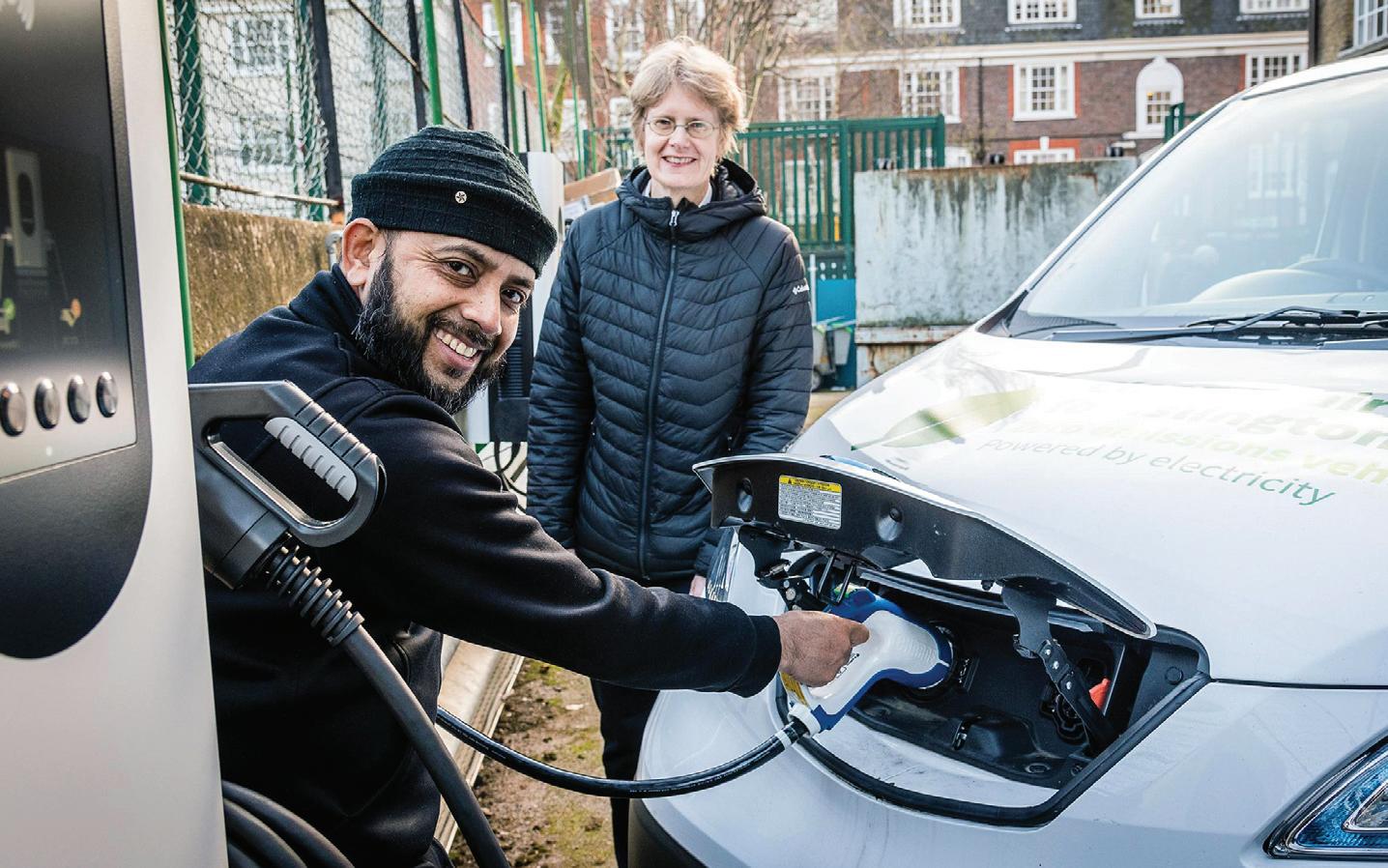
The new pricing structure will cut private car ownership and boost active travel, along with the use of car clubs and public transport, believes Rubena Hafizi.
She said:“Through our network of low traffic neighbourhoods, School Streets and cycleways, and the upcoming introduction of Liveable Neighbourhoods, we’re making it easier than ever for local people to enjoy the huge mental, physical, and environmental benefits of active travel. The changes we’ve made to parking permits are designed to directly address this.”
According to data from the 2021 Census, 33% of households in Islington own a private vehicle. This is the second lowest of any London borough, the highest being City of London, according to Islington Council.
The impact of the new permit pricing structure is being monitored by the council, which includes looking at permit sales, compliance, and vehicle movements. Islington also plans to liaise with other agencies such as Transport for London to monitor increases in public transport usage.
It currently costs £107 a year to hire a space in one of Islington’s bike hangars. Of the borough’s 500 hangars, 481 have been installed in what were previously parking bays, with the others on yellow lines and one on the pavement.
Rowena Champion, Islington Council’s executive member for environment, air quality, and transport, said the council was helping to improve air quality through the rolling out of seven low traffic neighbourhoods, 35 School Streets and electrifying its fleet. “But there’s more that we all can and must do to tackle this emergency, especially following the World Health Organization’s decision
to set tougher global air pollution targets. That’s why we’ve made significant changes to our current parking system, which encourage the switch to sustainable transport. The changes that we’ve made – including our bold, pioneering decision to introduce a hierarchical charging system for electric vehicles – ensure that parking charges more accurately reflect the pollution they create.
“While electric vehicles mostly have less environmental impact than petrol and diesel vehicles, they nevertheless cause pollution through the release of tiny particulates from the brakes and tyres, which can be breathed in and cause harm. Electric vehicles also contribute to congestion and take up road space, making roads less safe for people who are walking or cycling. Like petrol and diesel vehicles, they also take up valuable parking space, which could instead be devoted to environmentally-friendly measures like greening or tree planting.”
In 2007 Islington became one of the first local authorities in the UK to introduce emissions-based parking permits, with a diesel-surcharge introduced in 2015.
Mark Frost, director at Fern Consulting and Hounslow’s former assistant director of parking, transport and environmental strategy, described Islington’s multi-band tariff scheme as “significant”. He told Parking Review: “Clearly, Islington officers are right that the larger EVs have a far bigger footprint – literally and in terms of carbon and this should be recognised in policy in some way. This innovative variable tariff, still rewarding the most efficient EVs, whilst highlighting the impact of larger EVs, is potentially an elegant way forward. I suspect this will be the first of many such schemes.”

London Councils is consulting on increasing the level of penalty charges for parking and traffic contraventions on roads controlled by all the capital’s boroughs, including the City of London.
London Councils’ Transport and Environment Committee is responsible for setting parking, bus lane and moving traffic penalty charges on borough roads. The consultation focusses on penalty charge notices (PCNs) relating to parking and traffic enforcement and other additional fees relating to parking.
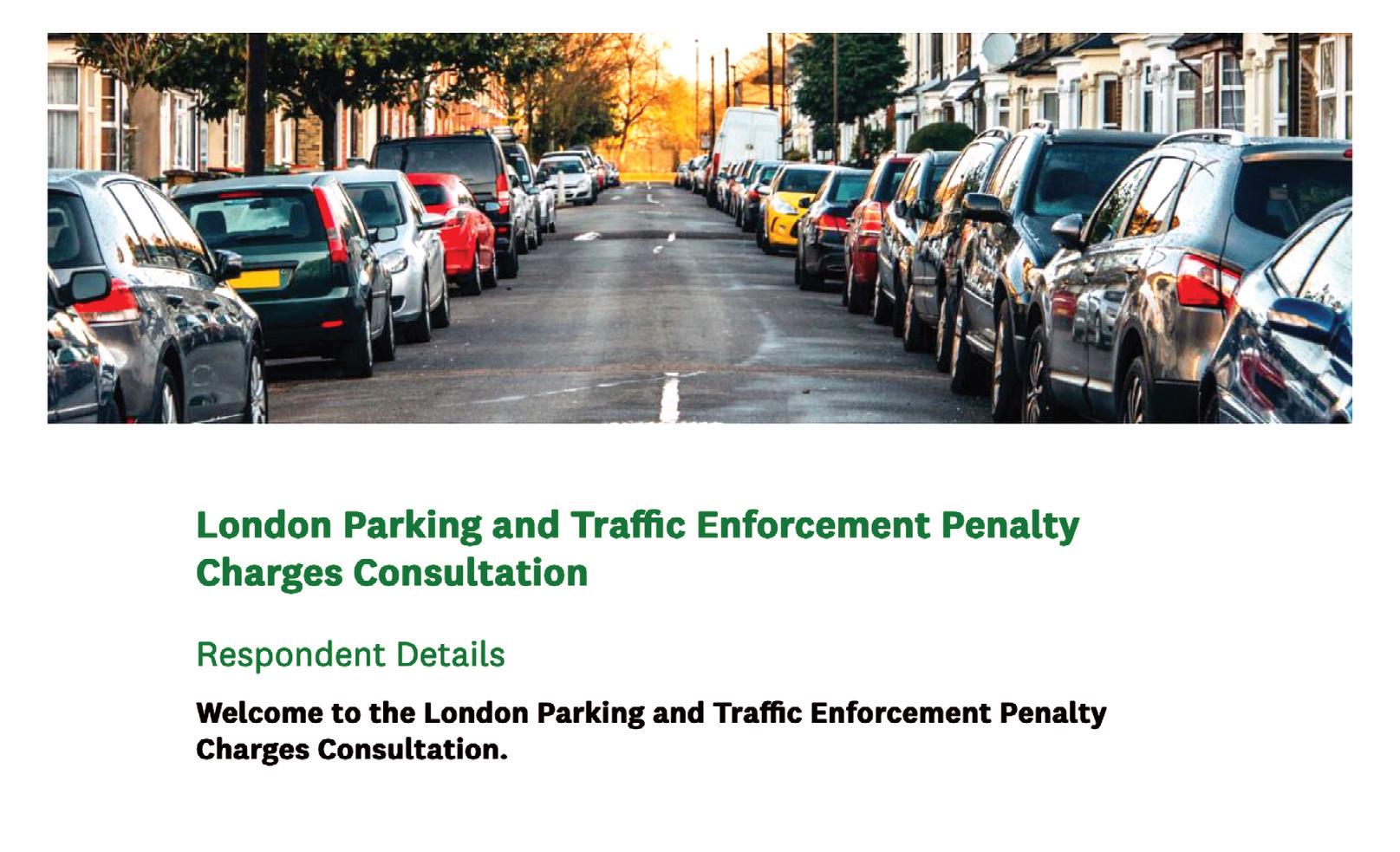
The committee has not reviewed parking, bus lane and moving traffic penalty charges since 2010 and many of the current charges and additional fees have not changed since 2007.
The number of PCNs issued in London has increased by 50% over the last 12 years and London boroughs are concerned that the current penalty charge levels are not high enough to encourage compliance and act as a deterrent.
London Councils says there are examples of people choosing to park where they are not allowed to despite knowing they will receive a penalty charge.
The impact of inflation on penalty charge levels has meant that there has been a reduction in the real value of these charges and additional fees over time. The costs to London boroughs for providing a parking and traffic management service have also increased significantly since 2011, says the committee.
The capital is split into roads controlled by London boroughs and those controlled by Transport for London (TfL),
which has similar responsibilities to London boroughs for setting penalty charges on their own roads – the Transport for London Route Network (TLRN), or Red Routes. In 2022, following a consultation in 2021, TfL increased parking, bus lane and moving
traffic penalty charges on the roads they manage from £130 to £160. The current maximum penalty charge level for contraventions on borough roads remains at £130.
Mayor of Hackney, Philip Glanville, London Councils’ exec-
Increasing the cost of penalty charge notices is opposed by the RAC.
The motoring association’s head of policy Simon Williams said: “We can see no justification whatsoever for putting up these fines. It’s bizarre that we’re now getting to the stage where a driver can be fined almost as much for an innocent mistake as they are for dangerously driving using a handheld mobile phone.
“There’s surely only one reason why any council would need penalty charge levels to rise to keep up with inflation – and that’s if they rely on the income they receive from drivers breaking the rules. This is inherently wrong and needs to change.
“Instead of relying on the
revenue, councils should be trying to understand the reasons why people are being caught out and improving signage, but this is never going to happen as it would cost them money and reduce their income.
“This is very much the case with yellow box junctions as many aren’t fit for purpose as they don’t comply with government guidance, meaning drivers end up getting fined needlessly. There also appears to be not a scrap of evidence that adding another £30 to what drivers pay if they drive in a bus lane or stop in a yellow box will make any difference when it comes to the number of contraventions as such a high proportion are innocent mistakes.”
The results of a consultation for the Department for Transport (DfT) into the processes by which Traffic Regulation Orders (TROs) are made, and how TRO data is made available and used, have been published.
The work was supported by GeoPlace, the British Parking Association and Ordnance Survey.
GeoPlace engaged widely with experts and with people and organisations who

required TROs. The project had input from over 200 individuals across more than 90 organisations and over 3,000 road users.
The aim was to understand who is reliant on TROs, how the process works for them and how we might improve it in the future.
GeoPlace worked with local highways authorities to understand how they create TROs and manage their TRO data, and released a number of surveys to understand:
utive member for climate change, transport and environment, said: “London boroughs are committed to making our roads safe and accessible for everyone. By effectively managing parking and traffic we can incentivise people to drive and park safely, protect access, crossings and junctions, and increase active travel such as walking, cycling and rented e-scooter use. We can also improve bus prioritisation, reduce carbon emissions and improve air quality.
“The consultation is a crucial part of the Transport and Environment Committee’s decision-making process on penalty charge levels and additional fees, and anyone who uses London’s roads can have their say on the new proposals. We are dedicated to ensuring the plans don’t negatively impact lower income and more vulnerable people and welcome all input into this consultation.”
The consultation runs until 23 October.
1. the costs incurred by local authorities to create Permanent Orders and Temporary Orders
2. the maturity of TRO Digitisation associated with features typically relating to TROs
3. the needs of individuals/organisations for data typically associated with TROs.
The DfT says results from this research will contribute to the future of mobility work for the Industrial Strategy Grand Challenge for the UK.
The range of vehicle-related permits is vast – from residents parking to emissions controls – and every organisation that issues permits – whether local authority or commercial company – adopts a different model. There may be different permits depending on the type of vehicle or size of engine; fuel type –petrol, diesel, hybrid or electric; engine size; or vehicle weight. The type of permit may vary according to location, or parking zones may be different, depending on the peak parking timings – for example parking may be restricted near schools during the school run period.
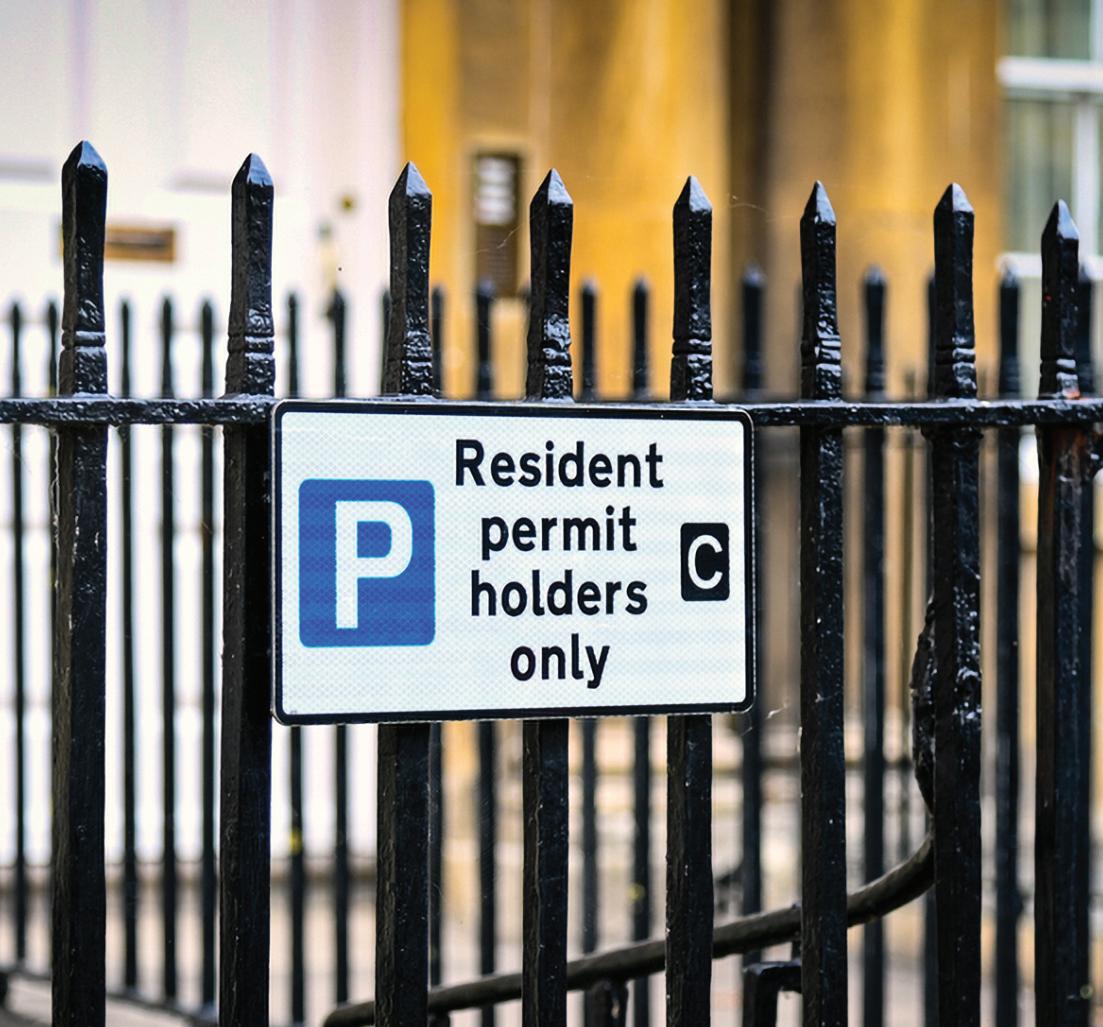
For authorities that have a clear view of how they want parking in their area to be administered, a ‘cookie-cutter’ off-the-shelf solution doesn’t cater sufficiently for different permit scenarios. That’s why Taranto set up discussion sessions with some of our longstanding local authority clients to find out what they really wanted in a permits solution.
Taranto’s clients not only wanted a flexible, highly configurable solution that could be adapted to a specific authority’s particular permits strategy, but they also were keen to make it as open and easy
to use for their residents, businesses and visitors. Encouraging users to apply for permits online in a simple, intuitive way not only encourages residents to manage their own permits, making life easier for them, but also reduces the workload for hard-pressed council parking teams. The result of the consultation is Taranto’s enhanced Parking Permits module, which can be set up to support a complex array of permit options at the back-end, and also focuses on user centricity, offering an easy-to-use online permit portal. The portal has a particular emphasis on accessibility to enable the chore of applying for a permit to be as intuitive as possible, making it even easier for anyone with a disability or special needs to use the permit system.
Taranto’s Parking Permit Portal covers the complete life-cycle of a permit, from initial application to renewal, including suspensions, changes in vehicle, temporary vehicles, as well as visitor permits. Renewal reminders can be set according to councils’ requirements to support their back-office processes. The portal can be branded with a council’s logo for greater user engagement.
From the back-office perspective, Taranto Parking Permits can be
Taranto is putting the user in the driving seat of permit application, writes Lewis Wray, Managing Director at Taranto Systems
used for local authorities residents parking or private car parks and can be configured for any permutation of permit that is required. Some local authorities such as Ealing Council are focused on their environmental strategy and as a result, have introduced emissionsbased permits. Ealing Council has adopted Taranto Permits solution to manage its Controlled Parking Zone (CPZ) which also covers emissions-based charging. This approach requires a DVLA lookup based on the vehicle data, which is cross-referenced to a pricing matrix in the back-office for pricing to be applied based on the emissions. Residents can receive a permit cost online based on their vehicle registration mark (VRM). Taranto Permits automates this complex process, to streamline the administration in the back office, as well as making the application process easier. The emission-based model helps with environmental targets, encouraging Ealing residents to adopt cleaner, lower emissions vehicles.
According to Shaan Motaleb from Ealing Council’s Parking Services Department: “This was a complex development with different bands for emissions and vehicles, but the results are extremely positive. Residents can now go online and enter their vehicle registration and instantly see the banding and cost for their permit. The data shows that the approach is working in terms of nudging people towards cleaner vehicles.”
From the end-user perspective, it’s important that the customer facing portal is easy to use and accessible. With that objective in mind, Taranto’s Parking Permits Portal has been designed in line with the Government Design System for digital services, with the interface created in the .GOV format. This approach is not only familiar to users of a wide range of government services, but is also designed with accessibility at the forefront and meets Website Content Accessibility Guidelines (WCAG). The Parking Permits Portal can easily be accessed on any device and dynamically updates, regardless of device, using Microsoft Azure as the development platform for ease of use and accessibility.
The portal enables users to access the system whenever they want, using any device making the permits system available 24/7. This means that if a resident realises their permit is about to expire, they can immediately go online and make a renewal or alteration, so updating the permit in real-time. The portal is compatible with assistive technology, to allow people with different abilities and special
Taranto’s digital first approach also extends to other aspects of permits such as visitor vouchers. The solution delivers visitor permits virtually, removing the need for physical visitor permits in for example, a scratch card format, which can be awkward to use, messy and wasteful.
Multiple permits, for example where there are several vehicles per household – are easily managed using the Permits Portal which can integrate all the permits related to a customer account holder. Adding supporting evidence for applications is also easier online and more intuitive, saving time and effort in a one-time upload.
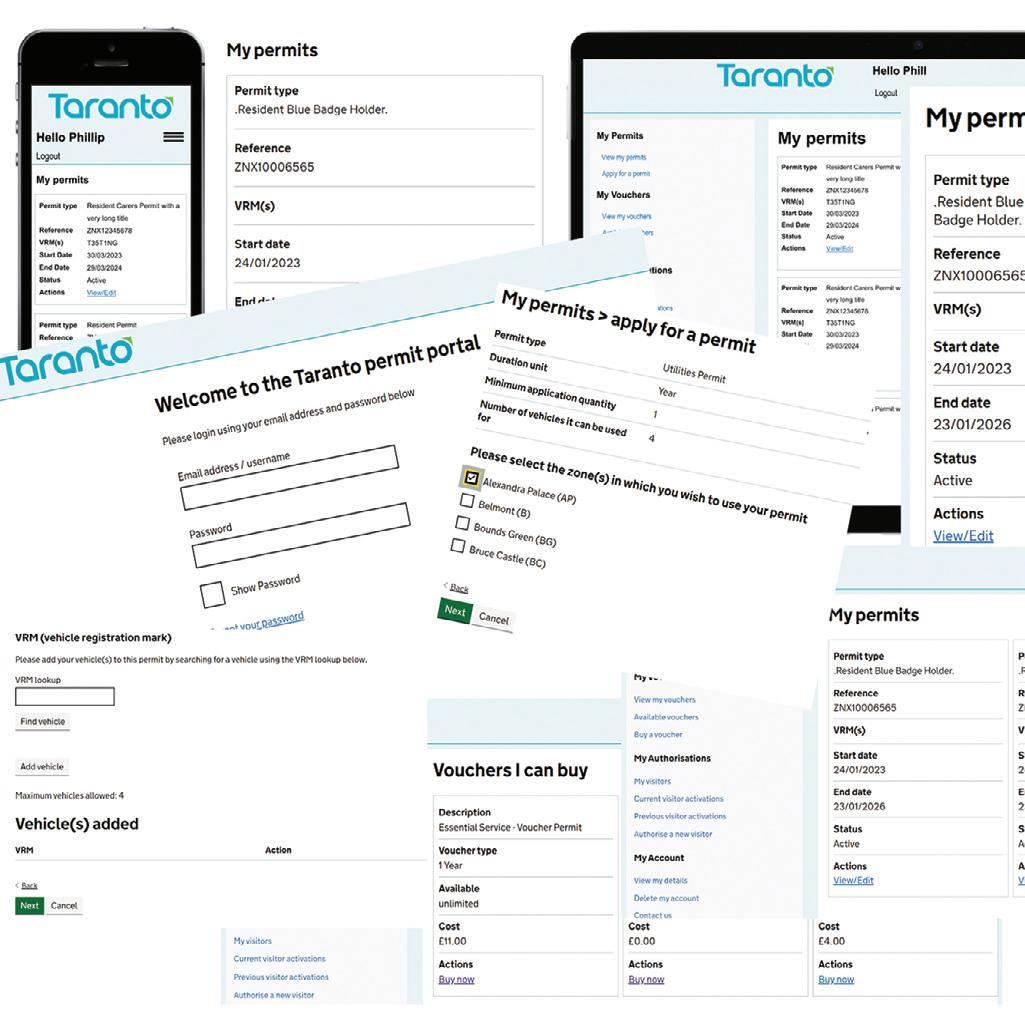
Taranto Permits also fully integrates with the Taranto Mobile handheld enforcement application, allowing Civil Enforcement Officers (CEOs) to check permit validity on their handheld devices in real-time. If a vehicle does not have a valid permit, the CEO then can immediately issue a PCN for integrated parking management.
“It’s important that we make the task of applying for permits as easy, accessible and intuitive as possible,” says Chris Murphy, Taranto’s Sales Director. “The .GOV format helps people to manage their own permit applications and also enables councils to minimise customer contact and ensures accuracy in managing parking permits. We are confident that the latest version of our permits portal will make life easier for our local authority and parking company clients, as well as local residents and businesses.”
For more information on Taranto’s Parking Permit Portal and how working with Taranto has helped Ealing Council visit www.tarantosystems.com
Lewis Wray is Managing Director of Taranto Systems and has guided the company through its growth over the last 14 years. Lewis has a background in consulting in transport, infrastructure and public sector.

Taranto leads the market in traffic enforcement and management solutions, with over 20 years’ experience of delivering innovation in the parking sector. Taranto works with local authorities, private parking companies and fleet firms to provide comprehensive parking, environmental and traffic management systems to keep traffic flowing smoothly and improve air quality, as well as reduce the administrative burden on back-office teams.
Taranto’s award-winning parking enforcement and traffic management systems are used by over 60 UK central and local government organisations, with over 12 of London’s 32 boroughs using our solutions.
Taranto is part of the global Modaxo Group, which specialises in new technologies and innovation in the transportation sector.
“Taranto’s Parking Permit Portal covers the complete life-cycle of a permit, from initial application to renewal”
Lewis
Brighton & Hove City Council has paused active travel improvements along the seafront, arguing that amendments are needed to avoid causing congestion. But the new Labour administration’s plans for a two-way cycle lane along Brighton seafront are merely a “cover up” to scrap an already designed and funded scheme, claims campaign group Transport Action Network (TAN).
Trevor Muten, chair of the council’s transport and sustainability committee, refutes the allegation. In a statement he said: “In response to statements, particularly from Transport Action Network, we reiterate that we are not scrapping anything. We are taking the original design and changing a few parts of it to make it safer.”
The original plan would have involved wider pavements, more pedestrian crossings, and a direct westbound cycle route. It would have cut the number of traffic lanes from four to three on a stretch of the A259 along the seafront, with one lane being given over to cycling. The scheme was fully funded by a grant from Active Travel England (ATE) and from the council’s Local Transport Plan’s capital allocation.
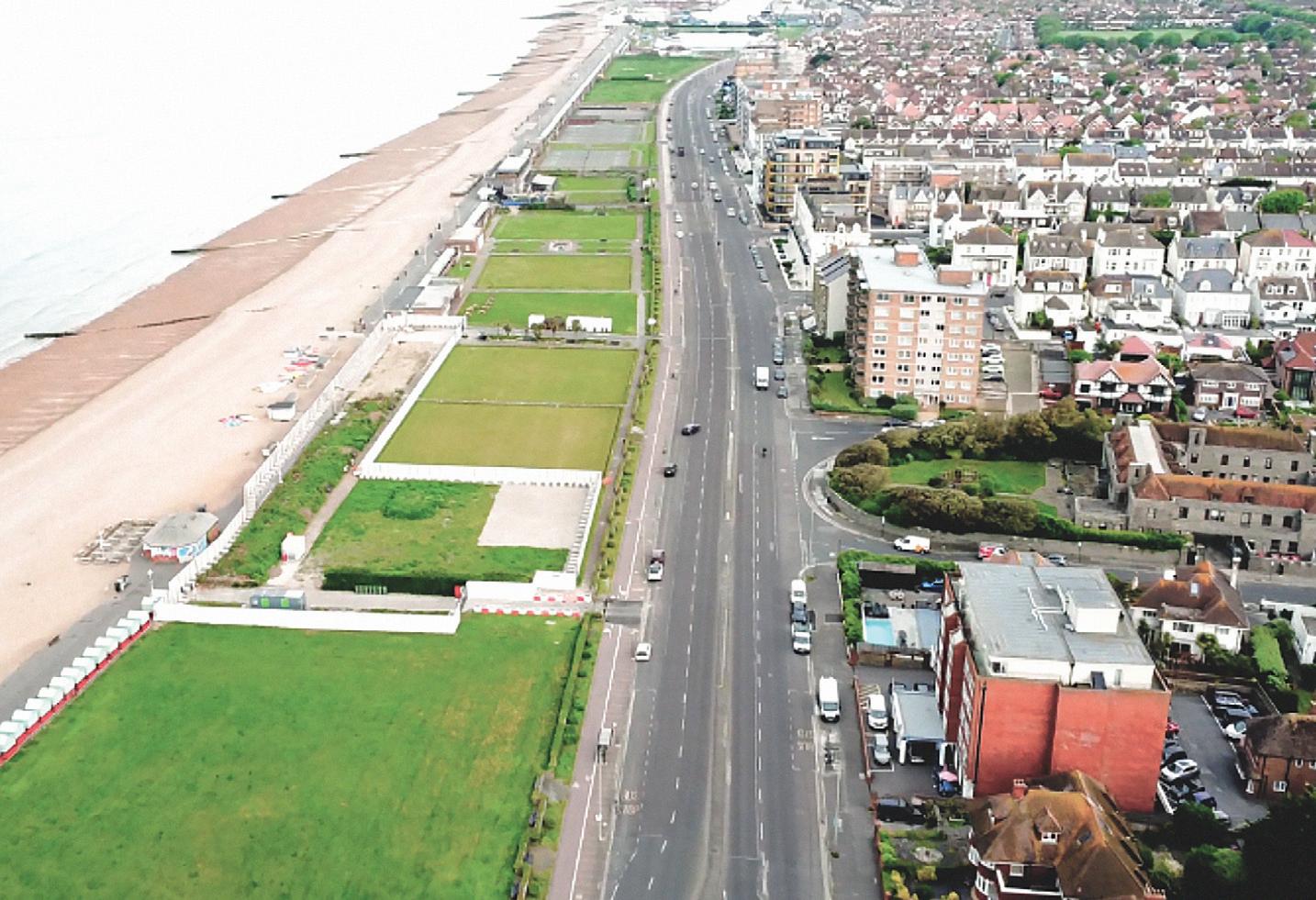
But the council now plans to maintain two lanes of traffic in each direction along the A259. “Two lanes for vehicles in both directions on the A259 means good access for buses and car-users including our disabled residents, the elderly and those with mobility issues,” said Cllr Muten. “We have learned from everyone using the first phase of the Seafront scheme, from West Street to Fourth Avenue, what does not work for cyclists, pedestrians or motorists – what creates traffic congestion and pollution. We must get the next phase, from Fourth Avenue to Wharf Road, right the first time.”
The seafront is an arterial road across the city for motorists, including those visiting the hospital, with other city centre routes kept clear of all traffic except taxis and buses, Muten pointed out. “We have to cater for everybody however they choose to travel,” he said. “We believe that a carrot works better than a stick. Providing safe cycle routes encourages more people to cycle. Good traffic flow along main roads avoids cars on smaller roads and avoids congestion. Accessible pavements, distinct from cycle routes, make walking safer.”
The council was concerned by some aspects of the original plan, said Muten, citing the creation of two separate cycle lanes – one going west, one east – with a
pedestrian pathway in between them. “People who walk that route often have dogs and/or children with them. So, we are creating one two-way cycle lane separate from the footpath,” he said. “We are also making the cycle lane simpler by ironing out a loop in the King Alfred area. And with clever use of the space, we are able to maintain two-way traffic on what is an important route into the city.”
Muten insists that this is an amendment to the original design rather than a completely new plan. “Had this been a usual situation officers would have, of course, been asked to present a fully-funded plan with sources of funding clearly identified,” he said. “On this occasion, as work was due to start on the design that we felt needed changing, we all had to act very fast in order not to incur further costs to the council. It would be financially irresponsible to continue with the existing scheme and at the same time plan to change it.”
Transport Action Network (TAN) estimates the cost of a major scheme that the council is now discussing is likely to be tens of millions of pounds, and that it is unlikely that this could be found. TAN director Chris Todd said: “The council’s ambition would be admirable if its real intent on scrapping pedestrian and cycle improvements wasn’t so blatant. If its concern was genuine it would proceed with the existing scheme while in parallel drawing up plans for a higher quality proposal for the future. Yet this is not an option being presented to councillors. The two schemes are perfectly compatible and proceeding in tandem presents the least risk financially and the best deal for local taxpayers.
“While we very much welcome a commitment not to scrap the scheme, it was clear at the committee meeting [on 21 June] this was not a few minor tweaks to address safety concerns, but a complete redesign.
As officers stated at the meeting the current proposals had passed safety audits. However, any delays are concerning.”
Todd noted that the Valley Gardens Phase 3 scheme, which would involve reworking of the roads from the Pavilion to the Palace Pier, has also been paused by Brighton & Hove City Council. “This is a critical scheme, designed to a high standard, to connect the city centre to the seafront,” said Todd. “This has left many people concerned that the rationale behind pausing schemes is not to seek better designs. As the Climate Change Committee said as it outlined the worrying slow implementation of net zero policies: pace should be prioritised over perfection.
“If this slowing down or scrapping of schemes continues, it will place millions of pounds of existing and future funding at risk. It will also be a signal that the administration is not serious about tackling the climate crisis.”
Labour won overall control of Brighton & Hove in May’s local elections. Bella Sankey, who became the new leader in May, was elected as a councillor in a by-election last December.
Cllr Sankey said: “Our decision has the potential to be a win-win-win for pedestrians, cyclists and road users. We passionately believe in promoting walking and cycling in Brighton & Hove and delivering the highest quality, permanent, active travel infrastructure. TAN’s accusations that we are trying to scrap the scheme are untrue.
“To suggest the changes will cost tens of millions of pounds is scaremongering. Time scales will be announced as soon as we know them, but officers have advised it will take six months for changes to be made to the design because we intend to retain a lot of the original scheme, for example the pedestrian crossings, extended pavements and pocket parks. We will only need to consult on the changes.”
Labour council denies claims it is covering up plan to scrap cycle and walking friendly scheme, reports Deniz HuseyinBrighton seafront
On-street residential parking spaces are to be removed in Lambeth to reflect the continuing fall in car ownership in the borough, the council’s David Wilson told delegates at Cycle County Active County.
Currently 60% of households in the south London borough do not own a car, and this will continue to increase, said Wilson, climate response and strategy manager, transport and public realm at Lambeth Council.
He estimates that 94% of kerb space in the borough is currently allocated to parked vehicles.
Under the Lambeth Kerbside Strategy, launched earlier this year, 25% of kerb space would transfer to “sustainable uses” such as bus lanes, street trees, sustainable drainage systems (SuDS), parklets and cycle parking. But some of this space would also be set aside for car clubs and disabled bays.
The £31.7m strategy is designed to help the borough meet its net zero target by 2030. By then “sustainable” kerbside uses, such as dockless bikes, parklets, car club bays and EV charging points, will eventually generate more revenue for the council than parking, Wilson predicted, though he did not specify when.

Re-allocating space to uses other than parking will support high street business, believes Wilson, with street trees, rain
More than 50 organisations have signed a letter calling on prime minister Rishi Sunak to legalise electric scooters. Currently, only rental e-scooters can be legally used on public roads through government trials, due to end in May 2024.
The signatories, which include councils, environmental charities and campaigners, warn that the UK is at risk of falling behind the rest of Europe in the roll-out of shared and zero-emissions transport including e-scooters. Signatories said that the trials have achieved more than 34 million journeys – with positive environmental and economic impacts on cities and towns. They raised concerns about an estimated 750,000 privately owned and unregulated e-scooters in the UK, which are “unlikely to undergo regular maintenance by trained professionals or have governmentmandated safety features”.
“Private e-scooters can cause concern for road users particularly disabled people in addition to potentially being unsafe for riders, however, this is where legislation and regulation can make a positive difference,” said the letter.

Six councils – Essex,Milton
A transport strategy called ‘Streets for People’ has been approved by the London Borough of Southwark to encourage more people to walk, cycle and use public transport. It puts the emphasis on transport at the very local level.
The council is launching a new app – Better Points Southwark –which tracks the user’s travel via GPS from their smartphone and rewards them with points that can be converted into vouchers, discounts in shops or used as charity donations.
gardens and parklets making them more attractive destinations.
The council is changing its kerbside pricing, so that the owners of vehicles that produce more greenhouse gases or take up more space will have to pay more for parking, said Wilson. “If your vehicle produces more exhaust or non-exhaust pollutants you should pay more. And if your vehicle takes up more space and increases congestion you should pay more,” he said.
Another initiative is ‘Try before you bike’, which gives people who cannot afford to buy a new bike the chance to hire one for free for three months. At the end of the three months, there is a choice to buy the bike outright, pay a monthly fee or return the bike, said the council. It is also seeking 25 “community influencers” from different communities, backgrounds and ages to take on the challenge of becoming cyclists. Over the year, they will be encouraged to share their stories to encourage people to try cycling.
Keynes, Somerset, North Northamptonshire, West Northamptonshire and West Yorkshire Combined Authority –have all signed the letter.

Other signatories include CoMoUK, Sustrans, Campaign for Better Transport, Urban Transport Group and London Cycling Campaign, along with micromobility operators Voi, Beryl, Dott, Ginger, Lime, Superpedestrian, Tier and Zwings.
Richard Dilks, chief executive of CoMoUK, said: “The evidence from the trials is that e-scooters are incredibly popular, with huge demand from users, and the UK has been left as an international outlier by not introducing permanent legality. To address the crisis levels of transport emissions in the UK and help people save money amid the cost-of-living crisis, the government can’t delay any further.”
The UK government has launched a call for evidence on the Private Parking Code of Practice, focussing on the impact of changes to charges and debt recovery fees.
Once introduced, the Private Parking Code of Practice –required by the Parking (Code of Practice) Act 2019 – will allow drivers to more easily challenge an unfair parking charge through a new independent appeals service, and all private parking operators will also have to follow the code.
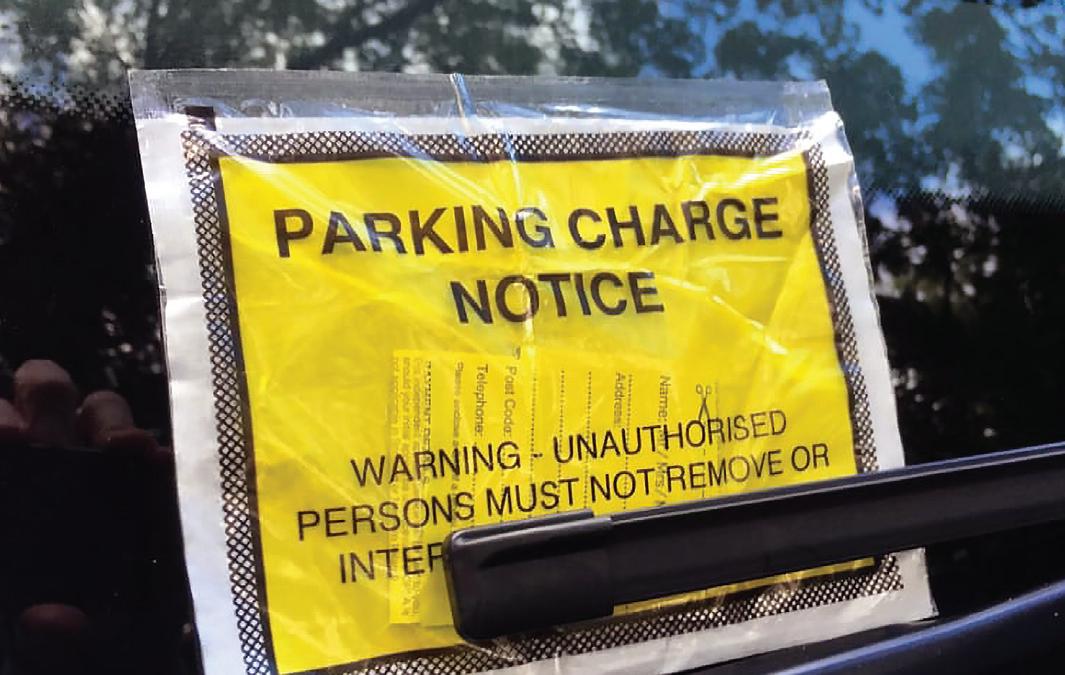
A draft single code of practice was unveiled last year, but withdrawn to allow further consultation on levels of fees. Options now under consideration include reducing the current £100 charge limit to £50 which would halve parking charges.
The government is also looking at potentially banning debt recovery fees altogether, which are currently as much as £70, or retaining existing limits.
The call for evidence on charges and debt recovery will pave the way for the development of the final Private Parking Code of Practice which will supersede the codes currently set out by the British Parking
Association and International Parking Community.
The new code will be complemented by the creation of a new appeals service, again replacing the distinct appeals systems set up the rival trade associations.
The government predicts the new code will ensure fewer drivers are penalised unfairly and tackle issues like confusing and misleading signs and a lack of grace periods.
Levelling up secretary Michael Gove said: “Millions of people across the country use private
car parks and we want this to continue without them having the fear of being slapped with unfair and costly charges.
“Our new Private Parking Code of Practice will put this right, delivering a much fairer system for drivers and industry. The call for evidence is an important part of shaping this policy. I encourage everyone to come forward and have their say.”
The call for evidence is focussed on understanding the implications of the measures proposed to address issues in

The British Parking Association anticipates the government’s Private Parking Code of Practice is still some time away, so has updated its Approved Operator Code of Practice. The BPA went live with Version 9 of the code on 1 August and introduced new complaints-handling clauses, tariff pursuit clauses and a number of other standard-raising clauses drawn from the government’s code.
the private parking industry, and to inform decisions on parking charges and debt recovery fees.
A draft impact assessment published alongside the call for evidence considers the following five proposals and how they will impact the sector:
Option1: Retain £100 charge limit with a 40% discount for paying within 14 days, with the debt recovery fees cap at £70.
Option 2: Charges set at two levels depending on seriousness of offence with £50/70 for England and Wales (outside London), £80/£130 in London and £80/100 for Scotland, with a 50% discount for paying within 14 days. Debt recovery fees would be reduced to 30% of charge levels.
Option 3: Same as the second option but debt recovery fees would be banned.
Option 4: Charges set at two levels depending on seriousness of offence at £70/£100, with the discount for paying within 14 days remaining at 40%. Debt recovery fees would be reduced to 30% of charge levels.
Option 5: Same as the fourth option but debt recovery fees would be banned.
The consultation is open until 24 September 2023. A further consultation is then planned on the options for parking charges and debt recovery fees.
measures installed on the roads in late 2020. The Royal Borough of Kensington & Chelsea removed the cycle lanes just seven weeks into a scheduled 18-month trial and before construction on the scheme had been fully completed.
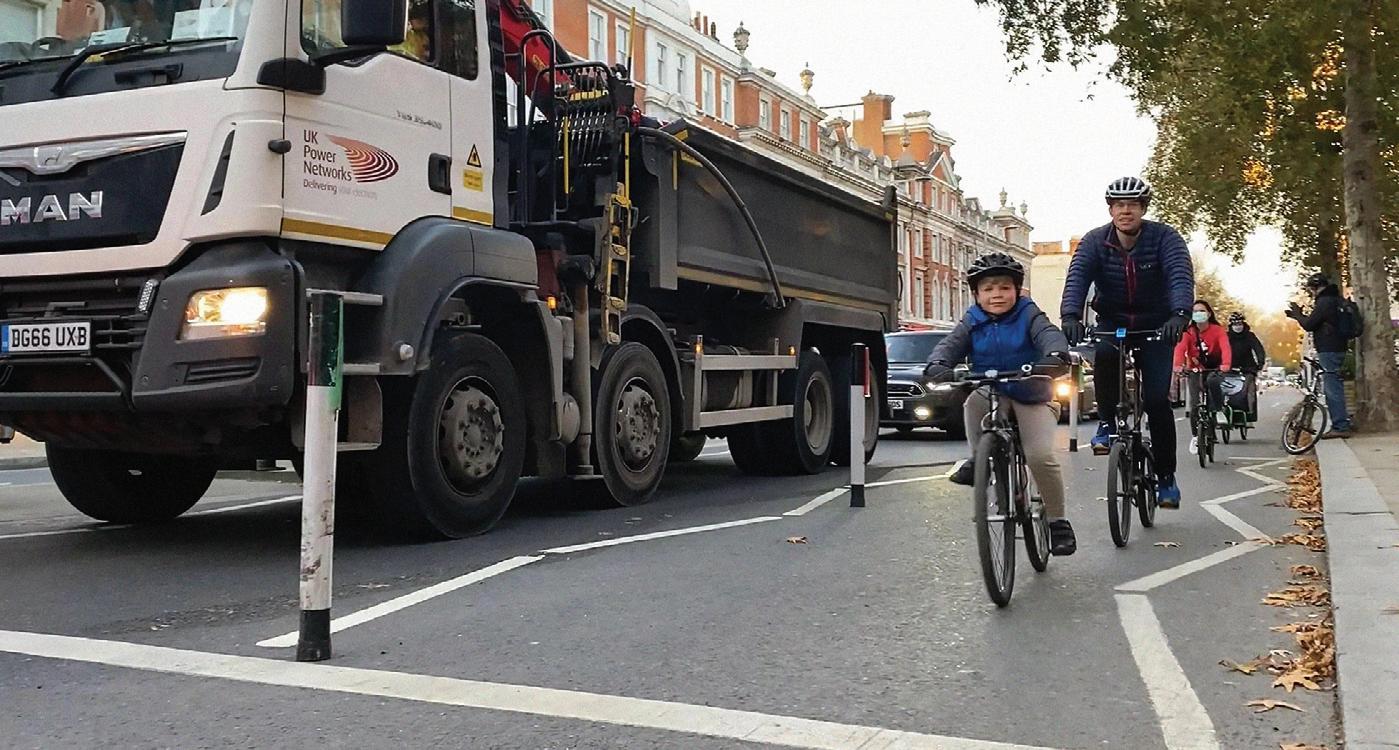
In March a High Court judge dismissed a legal challenge against the council’s removal of the protected cycle lane.
Kensington & Chelsea Council said its decision was in response to complaints from local businesses and residents. The local authority said that the segregated cycle lanes caused congestion and hindered the emergency services.
‘Advisory’ cycle lanes are to be installed on parts of Kensington High Street and Fulham Road after a majority of respondents to a public consultation backed the move.
More than 60% at least partially supported proposals to have the advisory
lanes on Fulham Road, and the eastern and western sections of Kensington High Street.
The lanes will be marked out with a broken white line, so there will be no physical barrier separating cyclists from motorised vehicles.
This is in contrast to the light segregation
Cllr Cem Kemahli, lead member for planning, place and environment, said: “It’s heartening to see that people are open to the idea of some cycling infrastructure on our streets and this scheme strikes the right balance between keeping our major through roads moving while allowing space for everyone.
“Road safety auditors made some suggestions to make the scheme safer and discourage close passes. I’m happy to have accepted these, as making our roads safer as well as greener is a priority for us.”
Gareth Hughes has been appointed as head of sales at Twin, a company that has developed a platform that manages payments for both parking and electric vehicle charging. Hughes will be responsible for establishing routes to market and driving sales for Twin’s payment app and terminals.

The appointment marks a return to parking for Hughes, who was previously head of sales (North) for APCOA Parking.

“I began my parking career in 2000 and entered the very first British Parking Awards in 2002 – the entry was for Bow Street car park in Bolton where we had installed a women-only floor in the multi-storey car park. I think we were runners up and the ladies only floor is still in place 22 years later.
“I left the parking sector in 2015 to focus on the growing EV charging market. Until Twin
came along these two sectors have always been mutually exclusive to one another.
“I was tempted back into parking by Ashley Kelley, the owner of Twin, to drive sales and raise the profile of Twin and more importantly to unite the parking and EV charging sectors.
“Twin is the first universal payment solution for parking, EV charging or both and I immediately saw the benefits of joining
Ashley to raise awareness of this new concept in parking and EV charging. The concept is simple, a payment system that can integrate and take payment at any of the many EV chargepoints, irrespective of their make and model. Twin also takes payment for parking, so basically there is no longer a requirement to have multiple credit card readers on every EV chargepoint and parking payment terminal.”
Project Centre has appointed Graham Storrie as its new managing director, following the move of Keith Hanshaw to become director of transportation at sister company NSL.


Storrie has worked for Project Centre as both regional director and director of operations for more than three years, working closely with clients across the country.
Storrie’s engineering career spans more than 25 years, working in the Middle East and the UK, in the public and private sectors. A Chartered Civil Engineer with significant technical knowledge he has worked across highways and infrastructure, transportation, structural engineering and the built environment.
Smart Parking began life back in 1992 as a small parking operator trading under the name of Perth Car Parks. In 2003, its technology arm was established in New Zealand, a move that paved the way for a series of back-end solutions to be developed in-house and which are now offered to clients.
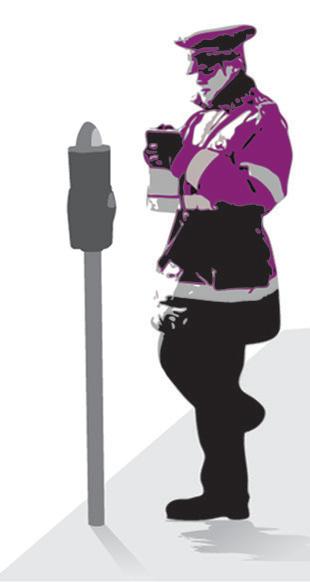
In 2012 the company rebranded itself as Smart Parking following the acquisition of Town & City Parking. Many members of Town & City Parking team are still with Smart Parking today. January 2013 saw the appointment of Paul Gillespie as the chief executive of Smart Parking. Under his leadership, over the past decade the company has continued

to grow and set up new operations in New Zealand and Australia during 2021, and moved Germany at the beginning of 2022.
During the same period, new acquisitions were also made through the purchases of Enterprise Parking Solutions in 2021 and NE Parking in 2022. This year has seen Smart Parking announce the acquisition of German-based Park Innovation.
Paul Gillespie said: “Moving forward, our focus will remain on offering clients an unrivalled system and service that they can truly rely on. The business is nothing without its people and it’s the people who will take the company to the next stage in our journey.”
We currently supply and have vacancies around the UK for Permanent and Temporary positions:
• Civil Enforcement Officers
• Environmental Enforcement Officers
• Parking Back Office (Appeals/Notice Processing/Correspondence)
• Parking Change Management
• Interim Parking Managers
• Car Park Attendants/Marshalls/Stewarding
• Parking Supervisors (Both Enforcement and Back Office)
• Parking Management (Both Enforcement and Back Office)
• Heads of Parking/Directors
• Parking Technologies (Business Development and Project Managers/ Field Service Engineers/General Managers)
• Off Street Parking (Business Development, Contract Managers and Regional Managers)
• CCTV Operators – SIA and BTEC qualified
Looking for staff or need employment?
Please contact our experienced team on:
Tel: 0203 668 5680
Email: parking@unity-recruitment.co.uk

Web: www.unity-recruitment.co.uk




The Promoting Awareness of Civil Enforcement through Reporting (PACER) Awards recognise local authorities who have worked to provide their citizens with a better understanding of parking management policies and performance.


The awards are organised by PATROL (Parking and Traffic Regulation Outside London), a joint committee of over 300 local authorities in England undertaking civil parking and moving traffic enforcement outside the capital (which has its own arrangements) and Wales.

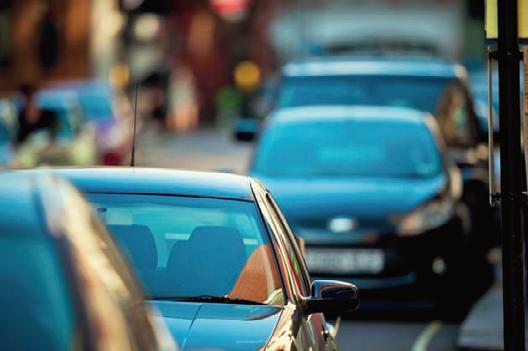

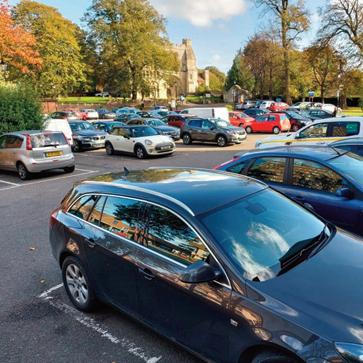
• North West: Cheshire East Council


• North East and Yorkshire: North East Lincolnshire Council







• Midlands: Nottingham City Council

• Eastern England: Central Bedfordshire Council


• South East: Hampshire County Council

• South West: Gloucestershire County Council
• Wales: Powys County Council

This year’s PACER Awards recognised the best annual report from across England and Wales outside London during 2021/22.
Other shortlisted authorities were: Bath & North East Somerset Council; Chichester District Council; Manchester City Council; North Essex Parking Partnership and Stocktonon-Tees Borough Council.
The awards event was held at the House of Commons on 11 July and was hosted by transport secretary Richard Holden.
Laura Padden, director of PATROL, said: “I’d like to congratulate all the award winners and those shortlisted, as well as thank all authorities that submitted an annual report for
consideration this year.
“We were grateful for the minister’s attendance and engagement with the event, and look forward to working together closely with his department on topics and issues that impact our authority members.”
Stuart Hughes, chair of PATROL, said: “It is vital for the public to understand that civil enforcement is not about raising revenue and needlessly penalising motorists, as is so often played out in the media. The PACER Awards are one way that PATROL can help get this message across.”


Oxford’s Zero Emission Zone is free for electric vehicles, but imposes a daily charge on petrol and diesel vehicles unless they have an exemption. To enable the accurate identification of non-compliant vehicles Conduent Transportation has devised a real-time Known Vehicle List lookup system
The development of a bespoke online vehicle emission checker, date selector and payment portal for the Oxford Zero Emission Zone scheme is building trust about the accuracy and efficiency of charging for cleaner air.
Oxfordshire County Council set out its net zero vision in the Central Oxfordshire Travel Plan (COTP) in September 2022.

The strategy features Britain’s first Zero Emission Zone (ZEZ), a safe walking and cycling network, a Vision Zero policy approach and traffic filters on certain busy city and county roads.
The ZEZ, in particular, has attracted much attention due to the innovative nature of its monitoring platform, enabling the council to gain useful insights before introducing a larger ZEZ across the city. Currently, the ZEZ pilot restricts polluting vehicles from entering certain streets between 7am and 7pm daily.
Zero emission vehicles such as electric cars can be used in the zone free of charge. All petrol and diesel vehicles, including hybrids, incur a daily ZEZ charge of up to £10 unless they have a discount or exemption.
The charge varies depending on the emission levels of the vehicle. Similar emissions-based charging schemes such as the London low emission and ultra-low emission schemes and government-mandated Clean Air Zones have a proven record of improving air quality.
Oxfordshire County Council has repeatedly said that the ZEZ is not about raising revenue. The county council’s clear policy is that it wishes to improve air quality, health and wellbeing. Revenue generated by the ZEZ pilot is used to cover the cost of the scheme’s initial set up and operation. Any net proceeds after covering these costs will be used to support local transport objectives such as supporting the transition of zero emission transport, improving walking and cycling facilities and incentivising public transport in Oxford. Part of “wanting to give people a better life” means ensuring that Oxfordshire’s citizens believe that the ZEZ is fair, accurate and transparent.
Oxfordshire’s ZEZ monitoring platform was created for the county by Conduent Transportation and has shown how local authorities can use multiple data sources to drive and enforce change. It developed an accurate and configurable ‘lookup engine’ that can be used with a wide range of traffic management schemes.

The Known Vehicle List system also generates deep vehicle data per lookup which can be used for future analytics. But it’s more than a sophisticated tool that can help to manage complex traffic networks effectively; its accurate data reporting
underlines the council’s message around positive changes to travel behaviour.
Doing the job right
“It’s a complex and challenging task to permit certain vehicles to enter into specific areas of a city freely whilst identifying and charging non-compliant ones,” says Pete Stone, Senior Software Architect at Conduent Transportation.
Implementation of Zero Emission Zones can only be a success if public and private sectors cooperate and trust each other, and if drivers are confident that data pertaining to their vehicles and their movements – and any charges implemented – are clear, accurate and fair.
The system operates by collecting vehicle registration mark data via automatic numberplate recognition (ANPR) cameras of vehicles entering the ZEZ and checking the vehicles emissions output against multiple databases.
The number plate data used to determine the appropriate charge comes from the user entering their vehicle number plate details into the online system (and not from the ANPR cameras). The number plate data gathered by the ANPR cameras is used for enforcement of the scheme and to provide supporting evidence for a penalty charge
The challenge
Build an integrated vehicle list that is:
• Compatible with Zero/Low Emissions Zones and exemption lists
• Integrated into the back office to pull cashless and permit data
• Allows for easy and intuitive camera enforcement management.
The process
• A balance between a feature, workflow rich product and usability to allow for easy changes
• Simple and clear management of camera groups and lookup processes allowing for multiple enforcement types.
The result
• Emissions based charges, with a high confidence on accuracy
• Discounts for permit holders where applicable using real-time data
• Ability to pre-pay for access to the Zero Emission Zone.
notice (PCN) in cases of a failure to pay the appropriate charge. The system uses vehicle CO2 (g/km) data, fuel type and the emissions standards (Euro standards) in determining the appropriate ZEZ charge.
“The key issue we found when creating the platform for the ZEZ in Oxfordshire was that key data, such as that from the Driver and Vehicle Licensing Agency (DVLA), wasn’t necessarily complete or totally accurate,” says Stone. “In several cases, older gas-guzzling Subarus had been classed as zero emission vehicles because of the way they were originally registered. So in order for a ZEZ platform to function correctly, it needs to cross-reference multiple data sources.
“Our platform is unique in that sense. Once the basic parameters are in place, the system can be adapted to work with Healthy Streets schemes, congestion and air quality control schemes, Low Traffic Neighbourhoods (LTNs), Liveable Neighbourhoods and School Streets. It’s a flexible and valuable tool, and easily scalable and adaptable for any local authority’s requirements.”
It’s up to local authorities how they wish their pricing models to operate; they are all fully configurable, says Stone. Clients can set different thresholds, whether relating to emission status, CO2 emissions, vehicle class, emergency service status, residence permit data or parking permit status. “Our approach is about bringing all these different sources of data together in one platform and using them in the best way for our customers. We’ve made sure to design the system with foresight that we can add in new data sources to the mix without too much effort.”
Going forward, Stone adds, data is the key to unlocking the ability to manage each vehicle on the network individually. “Over time, the quality of DVLA data improved, so we use that as our first source and then go to second and third sources, namely Driver and Vehicle Standards Agency (DVSA) and UK
Vehicle Data (UKVD). Any other sources that have a good API interface can also be added, so if there are use cases that need slightly different data then we build in an access route for those. But the core data sources used by local authorities are free to access using the authority’s credentials. This is how we can ensure that our clients are getting best value for money.”
Oxfordshire County Council and Oxford City Council have worked closely together on planning for the scheme, engagement and communications to residents and partners. “Using an accurate and flexible platform that like Conduent’s is one way to reassure citizens they are being treated fairly and reasonably,” says Stone.
The platform offers multiple points of contact for drivers and a robust system of check and balances, which updates in as “near to real-time as is humanly possible”. The latest system ‘lookups’ on payments, exemptions and tickets are always as up to date as possible. The platform is adaptable and scalable for any particular use cases.

Bryan Evans, Senior Transport Planner from Oxfordshire County Council, said: “The ZEZ pilot’s customer-facing online systems and arrangements for off-line customer access ensure that the scheme’s operating systems are accessible to all users. A major innovation in the ZEZ pilot has been the development of a bespoke online vehicle emission checker,
date selector and payment portal. It operates by users entering their vehicle registration number. The checker then looks up vehicle details from various databases via application programming interface (API) links to determine the vehicle’s emissions. It instantaneously displays the vehicles charging band and daily charge to the user, taking account of any applicable discounts.
“A key benefit for the public is the ease of use: all drivers need to remember and do is to enter their vehicle registration number –the system will tell whether and how much they need to pay if they wish to drive in the Zero Emission Zone. The system is highly configurable to accommodate potential changes to the scheme such as to emissions bands and charges. The scheme is attracting substantial interest among other authorities both within and beyond the UK. Its successful implementation sets a precedent for authorities looking to implement emissionsbased charging schemes.”
Conduent Transportation is a leading provider of automated and analyticsbased smart mobility solutions for government agencies. These solutions span roadway charging and management, parking and kerbside management, and advanced transit and public safety systems. Our intelligent kerbside management systems enable an improved customer experience and provide operational efficiencies by augmenting the integration of people, technology and data for our customers and drivers.
transportation.conduent.com

An accurate vehicle lookup platform reassures citizens they are being treated fairly Pete Stone, Senior Software Architect, Conduent Transportation
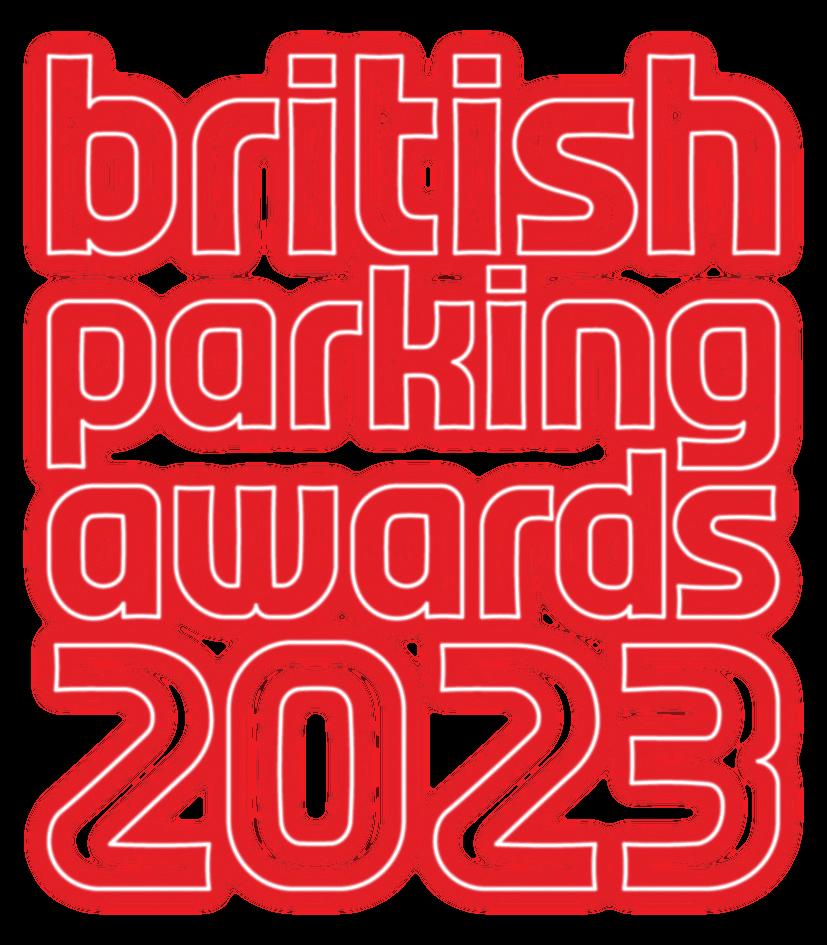









There is a lot to celebrate this year. It is the 21st anniversary of the British Parking Awards, a competition launched by Parking Review in 2002 to recognise excellence and achievement in a sector that provides what is an essential public service
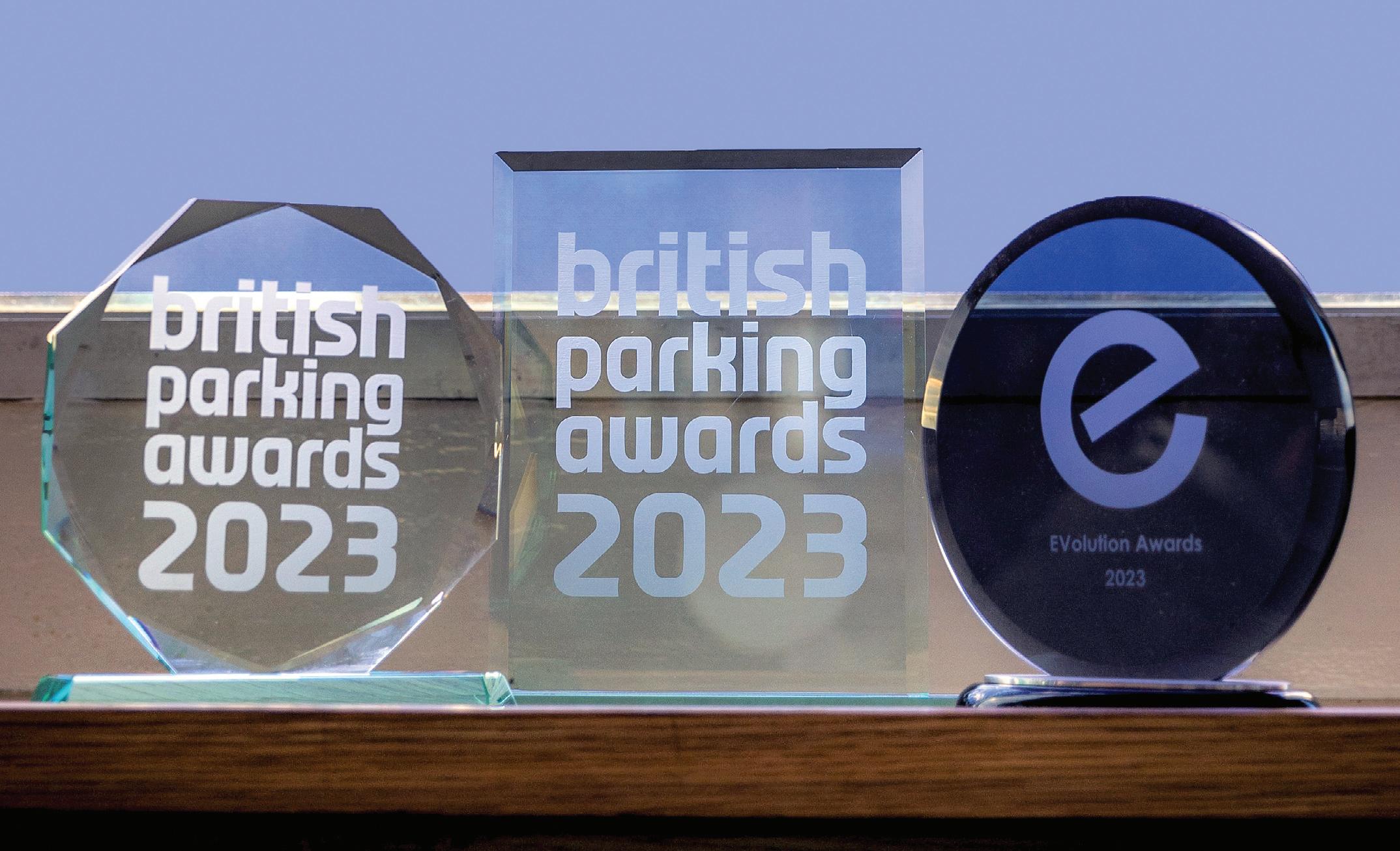
This year we received over 130 entries from across the public and private sectors, often working together. Over the summer, our jury of independent-minded experts has assessed, compared and debated the entries to select the finalists.


The winners will be revealed by our special guest compere Mark Steel at a gala lunch at the Royal Lancaster London on 15 September
The anniversary lunch, which sees people working in a wide range of disciplines gather together, is the social highlight of the parking sector’s calendar.
I hope to see many of you to mark the coming of age of the British Parking Awards.
Meet our host... Mark Steel
The British Parking Awards 2023 will be presented by the Sony and Writers’ Guild Awardwinning Mark Steel, presenter of the much loved BBC series Mark Steel’s In Town.

The British Parking Awards features a number of special and surprise trophies.
Presented by MiPermit
The MiPermit Inspiration Award recognises individuals and organisations that have made a significant contribution to improving parking. Inspiration Award recipients are exemplars of excellent practice that have inspired colleagues, clients, partners and the wider parking community.
Sponsored by The British Parking Association
The Lifetime Achievement Award will be presented to a parking professional who has made an outstanding contribution to the sector.
Presented by Parking Review
An award presented to an exceptional entry that has impressed the jury.
School Streets
Sponsored by: Conduent Transportation
The School Streets Award recognises innovative approaches to managing vehicle access at the start and end of the school day.
Hackney Council
London Borough of Waltham Forest
Sponsored by: DCBL
The Safer Spaces Award recognises how parking policy, design and management practice can deliver safer streets and car parks.
Tackling nuisance vehicles – Hackney Council
Community Matters – London Borough of Waltham Forest working with NSL and the Metropolitan Police
Sponsored by: EVC
The Connected Parking Award recognises how the provision of accessible and discoverable parking connects people, places and businesses..
AppyWay, TfL London FreightLab and Royal Mail – Creating an accessible kerbside for freight
Egis, AppyWay, Arvoo, Imperial, IPS and RingGo – A multi-partners approach to the digitalisation of parking and enforcement in a ‘smart city’ environment
JustPark – In-car instant booking
Kent County Council – The Park Map Project
Sponsored by: RingGo
Charles Cridland, Chief Information Officer, YourParkingSpace
Karen Day, Parking Manager, Nottingham City Council
Phil Hammer, Parking Operations Manager, Cambridgeshire County Council
Dan Hubert, Founder and Chief Executive Officer, AppyWay
Jade Neville, Head of User Experience, Conduent Transportation
Chris Whapples, Structural and Parking Consultant, Stripe Consulting
Sponsored by: CPG Europe
Vass Constantinides, Senior Consultant, Smart Transport Hub
Genesio De Costa, Contracts Monitoring and Support Officer, Hackney Council
Nisha Damhar, Associate Consultant, WSP Liveable Places
Nicolle Davenport, Legal and Compliance Assistant, Parking Control Management (UK)
Joshua Macdonald, Business, Products & Communications Manager, Cornwall Council
Sponsored by: CDER Group
APCOA UK Lambeth Parking Team
Cornwall Council
Durham County Council and NSL
Hackney Council Parking Enforcement Team
Nottingham City Council Parking Services
ZZPS
Sponsored by: Ballast Nedam
B4 Parking, Birmingham
Durham County Council and NSL
EF International Parking Services
Q-Park
YourParkingSpace
Communication Award
Sponsored by: ZatPark
The Parking & Enforcement Plan – Hackney Council
Car Park Design – Institution of Structural Engineers (IStructE)
Bringing more Sustainable Streets to Lewisham – Lewisham Council and Project Centre
We’re standing out from the crowd – RingGo
The Back Office Award
Sponsored by: Newlyn
Customer Service Centre, APCOA UK
Notice Processing Team, Cambridgeshire County Council
Administration Team, Parking Control Management (UK)
Liveable Places Parking Team, WSP
The Front Line Award
Sponsored by: tap2park
Rose Ansah, Senior Civil Enforcement Officer, NSL, London Borough of Islington
Adrian Rapa, Senior Operative Team Leader, Parking Control Management (UK)
Paul Moorton, Nuisance Vehicle Officer, Hackney Council
Kehinde Okubule, Civil Enforcement Officer, Hackney Council
Andra-Gabriela Stoian, Civil Enforcement Officer, Hackney Council
Resmije Zeka, Senior Civil Enforcement Officer, APCOA UK
www.britishparkingawards.co.uk
Sponsored by: Go2Sim Systems
AppyWay – Blue Badge toggle
AppyWay – The Parking Platform
Barbour Logic – Voice Master
Egis – Dispatch
JustPark – In-car instant booking
ParkingEye – Bay Management
Projects
APT Skidata, St John’s Shopping Centre and Apex Parking
Derby City Council – Moving traffic enforcement
London Borough of Haringey – Tackling Blue Badge fraud
Q-Park – Visitor Parking Portal
Unity5 and North East Lincolnshire – Zatpark Flexible Enforcement
Sponsored by: APT Skidata
AppyWay, TfL London FreightLab and Royal Mail – Creating an accessible kerbside for freight
Conduent Transportation, Reserve Forces and Cadets Association and the Forces Employment Charity – Promoting parking as a sector of choice for the military community
Kent County Council – The ParkMap Project
Lambeth Council – National Blue Badge Day of Action
London Borough of Waltham Forest in partnership with NSL and the Metropolitan Police
Penham Excel and Sandwell Council – Cross-boundary working
Sponsored by: The International Parking Community
Ask for Angela and parking initiatives that protect women and girls while enhancing community safety – Conduent Transportation
Fairer Emissions Based Parking – Lambeth Council
Community Pillar – PayByPhone
Best New Car Park
Sponsored by: Your Parking Space
Urban car parks
New Market Parking, Chester – Cheshire West and Chester Council (AHR and Vinci Construction UK)
Stevenage Multi-Storey Car Park – Stevenage Borough Council (HUBER car park systems and Fatkin)
Riverside Sunderland – Sunderland City Council (Sir Robert MacAlpine, Tonkin Liu and Goldbeck Construction)
Hospital car parks
Dorset County Hospital MSCP, Dorchester – Dorset County Hospital
NHS Foundation Trust (Prime, Willmott Dixon and Stripe Consulting)

Queen Alexandra Hospital MSCP, Portsmouth – Portsmouth University University NHS Trust (Ballast Nedam and Stripe Consulting)
Adanac Health & Innovation Campus Park & Ride, Southampton –University Hospital Southampton NHS Foundation Trust (Prime, HUBER car park systems and Fatkin)
Bath Podium Parking – DTZ Investors (Cushman & Wakefield, Makers, Cogent Building Consultancy, Potter Church & Holmes Architects, Stripe Consulting, QuinnRoss, Parking Matters and Concert)
St Catherine’s Walk, Carmarthen – APCOA UK
Merry Hill Shopping Centre MSCPs – Savills UK (Cemplas UK, Radlex Contract Services, Avonstar Metal Fabrication and IKO)
Details correct at the time of going to press
The world of parking and EV charging are connecting. This convergence is covered by EVolution, a new channel developed by the Parking Review team to look at zero-emission travel.
For second year the British Parking Awards will present a set of trophies reflecting the interplay between the parking and electric vehicle infrastructure sectors.
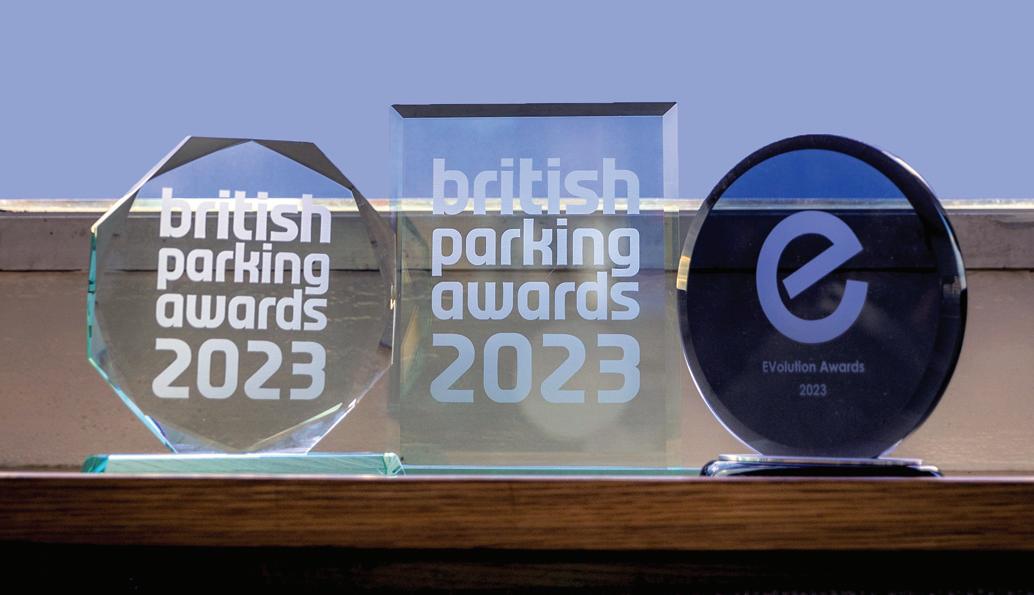
Sponsored by: Marston Holdings
The EV Champion of the Year is an individual or organisation that has had a significant impact on progressing the transition to zero-emission driving. The recipient may be a policy-maker, campaigner, technologist, business or organisation.
APCOA UK
Islington Council
Zapmap
The EV Chargepoint Provider Award will recognise the work being done by organisations enabling drivers of electric vehicles to recharge on their journeys. The category is open to chargepoint network operators, parking operators and specific destination managers providing EV charging facilities.
APCOA UK
Cheshire & Chester West Council
EVC
Q-Park
The EV Technology Award will recognise the development of innovative approaches to providing electric vehicle charging infrastructure, systems and services.
3ti – Papilio3 Solar Car Park
ParkingEye – Evology chargers
Local Car Park Management – ParkWise Disabled Accessible EV Parking
Twin – Universal payment system for EV charging and parking
Zapmap – Connecting chargepoint operators with EV drivers
Local authority teams from across the North of England and beyond converged on Newcastle Civic Centre’s awe-inspiring Banqueting Hall on 11 July for a day of topical debates and networking. The North East Parking Show was a forum in which parking management teams discussed traffic management schemes, clean air zones, event management, parking payment trends and career development, and where leading technology and service suppliers had an opportunity to showcase their latest projects.
Hosted by Newcastle City Council, which co-programmed the event with Parking Review. The North East Parking Show was organised by Landor LINKS and sponsored by RingGo.

Local authorities across the North East of England share a common desire to decarbonise transport, improve air quality and enhance accessibility, thus supporting local communities, businesses and economies. Christine Heriot, director of operations and regulatory services at Newcastle City Council, and David Hall, assistant director, operations and regulatory services, outlined the issues facing a major regional city and the challenges these pose for parking and traffic management teams. These include minimising traffic congestion, ensuring road safety, improving air quality and achieving net zero by 2030 while delivering customer-centred parking services.
The ‘Routes to Recovery’ session saw local authority teams from around the North East provide a regional perspective on key traffic and parking issues: Speakers included Lynne Ryan, service manager, parking services at Newcastle City Council, Peter Broxton, parking and transport infrastructure team leader at Durham Council, and Andy Waters, parking and streetworks manager, Gateshead Council.
The North East Parking Show then welcomed a special guest from the East Midlands – Nottingham City Council. Matt Ralfe, innovation and change manager, discussed how Nottingham has devised and implemented a series of parking policy measures such as the workplace parking levy and mobility hubs designed to tackle traffic congestion and improve air quality while supporting the city’s economy and meeting community needs.
The parking sector has always been open to adopting and developing new technologies for payment, enforcement, data sharing and the provision of electric vehicle infrastructure. The technology session at the North East Parking Show explored how the digitisation of payment and information services is transforming parking.
Stuart Harrison, president of the British Parking Association and chief technology officer at Intelli-Park, discussed initiatives such as the National Parking Platform (NPP) and Alliance of Parking Data Standards (APDS), through which the association is playing a key role in developing new standards and sharing best practice on their use.
There were expert presentations on digital innovations by a panel of technology companies: Jason Barbour (Barbour Logic), Andy Stott (RingGo), Matt Terry (AppyWay), Richard Williams (Transfer360) and Leadley Wilson (Unity5).
Managing parking is often seen as a challenging job. But it is also rewarding one for many people. The afternoon saw BPA chair Anjna Patel MBE share her personal career path and outline the work being done within the sector to both improve working conditions and to develop approaches that encourage more people to build a career in parking. She set out work what the BPA is doing in providing support networks, access to best practice mentoring and undertaking formal qualifications.
‘My Career Journey’ was an interactive session that saw a number of parking professionals share their personal development stories. Participants included: Newcastle customer response and enforcement officers Philip Boyes and Claudia Jewell, as well as Chris Head, senior business development manager at RingGo.
The panel discussed ways to improve staff retention, suggesting placing greater emphasis on team building and the importance of creating supportive bonds between employees.
The event’s chair and co-programmer, Steven Foster, team manager, Parking Services, Newcastle City Council, reflected on what had been a day where delegates and exhibitors alike had learned much by sharing their ideas and experience. “Thanks to everyone for a really successful North East Parking Show 2023,” he said. “It was fabulous to have the opportunity to bring colleagues together regionally and nationally.”





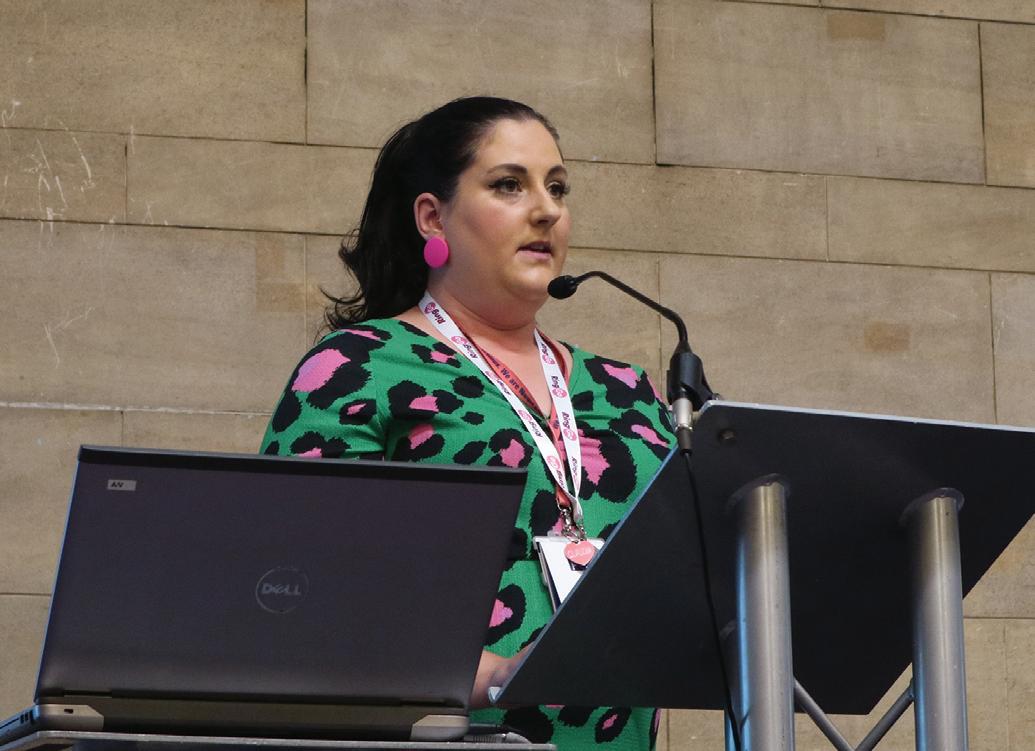

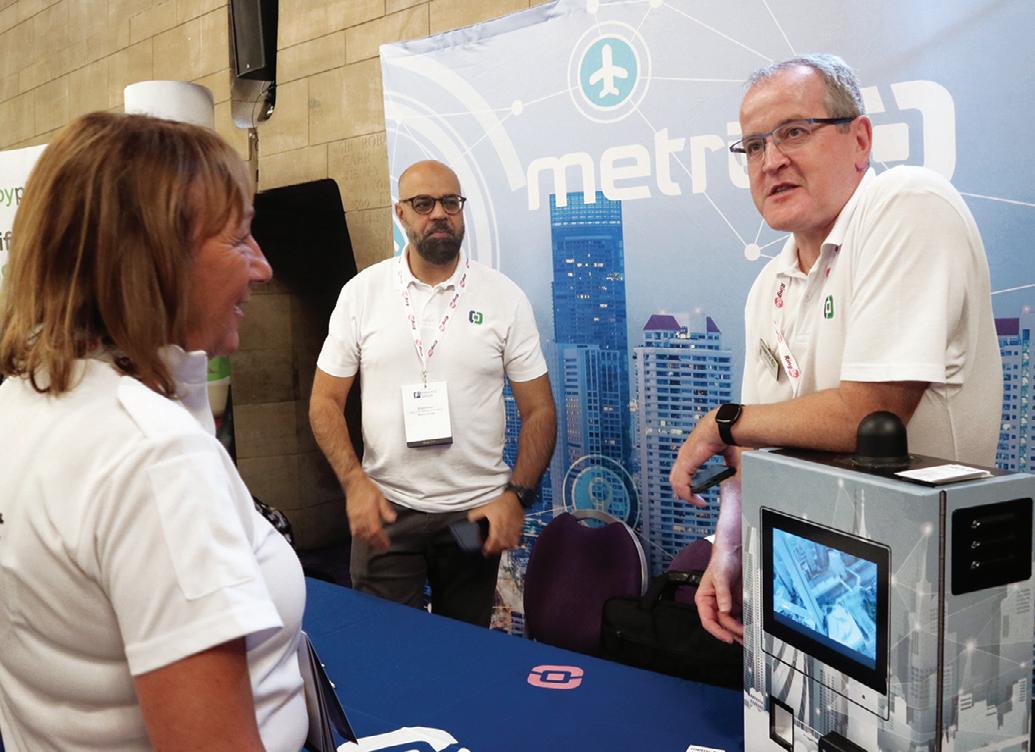
BPA members work hard every day to ensure that we keep people moving and get to where they are going in their millions each and every day. Our private and public sector members are now working more collaboratively than ever before, through necessity and often through adversity, coming together to find solutions as a result of significant issues we face across our sector.
The BPA has, over 53 years, earned the respect of governments as trusted and credible advisors. While the deterrent effect of parking and penalty charges may be politically complicated, it is great to see our diverse BPA community doing what it does best. Coming together to evidence why charge levels need to provide a sufficient deterrent to enable effective parking management. This remains a priority and we will continue to work diligently to achieve this.
I’d like to thank Lord Lucas for hosting us in what is a new venue for the BPA’s annual reception, the House of Lords, which is the second chamber of the UK Parliament. The house plays a crucial role in examining bills, questioning government action, and investigating public policy.

Indeed, The Parking Code of Practice Bill made its original journey through both Houses before becoming law in 2019 and this year, we hope to finally see the publication of the new code of practice and the framework that will deliver higher standards in the regulation of private parking. It has been a long road to get to this point, but the achievement should not be underestimated.
It’s such an honour to have the opportunity to represent a sector I have now been a part of for almost 15 years. I have been actively involved in the BPA community for eight years
across various boards and working groups. For that entire period, I have been at the same company. UK Parking Control, which is now part of Intelli-Park Group. The company’s own journey mirrors many of the changes seen in the parking sector. For example, it reflects the changing demand for parking and the change to more data-led solutions that provide enhanced resolutions to often complex problems. I would like to thank the owners and senior team at Intelli-Park for their support in allowing me the space and time to fully commit to this leading role.
The BPA community contributes significantly to society and to our economy and, together, we have a key role to play in supporting growth as we continue to emerge from the pandemic.
Our towns and city centres, our high streets, our business, our hospitals – they all depend and rely on well-managed, wellmaintained, structurally sound parking facilities that are safe and accessible for everyone.
Our strength is in our diverse and inclusive BPA community. Whether we work in the public or private sector, it is important that we work collaboratively, where possible, to raise standards, change perceptions, and demonstrate our commitment to a cleaner, greener, and safer society through effective parking management.
Our membership community continues to evolve and reflect the increasing complexity of our dynamic sector. Just compare the exhibitors at our trade show Parkex this year to 10 years ago with much greater focus on technology, data, environment and with a global outlook. Our new three-year strategic plan demonstrates our association’s relevance and it is clearly needed now more than ever before. Whether it is electric vehicles, the National Parking Platform, data standards and the work of the APDS, our BPA community continues to come together in record numbers to solve problems and work with partners internationally to find solutions.
I am delighted to see progress on Park Access, an accessible parking and charging accreditation which was launched at Parkex. Our aim is to provide a reliable data source for drivers with accessibility needs, parents with children, and others, so that they can locate safe parking and charging destinations when journey planning. We are grateful for the support of Graham Footer from Disabled Motoring UK and disability travel champion Helen Dolphin MBE for making this project happen.
As many will be aware a key focus of our council is the continued professional development of individuals working in our sector and to this end, we recently launched BPA Advance.



This new professional development membership is designed to support our parking community and its employees, both public and private sector, through training, wellbeing, mentoring and more. This is our fastest growing membership type, offering exceptional value and as a not-for-profit organisation we will continue to invest and drive forward a culture of professional development. BPA Advance is already helping members with training, compliance, and ongoing professional development.
Journeys often begin and end in a car park. Safer Parking Scheme integration will show people the safest route and the most secure car parks to assist with journey planning. The Safer Parking Scheme is a success story that goes from strength to strength. It has recently been extended to include Park Mark Freight, a dedicated accreditation aimed at raising standards in truck and freight parking facilities and has received great support from the Department for Transport, the Road Hauliers Association, the National Vehicle Crime Intelligence Service and more.
I would like to recognise supporters who help us maximise the impact of our events and initiatives. Over the last year, DCBL’s support has enabled us to develop a technology solution to raise awareness of the Safer Parking Scheme to the extent that we are now able to share, via an API, safer parking data with parking app providers and will soon be able to identify Park Mark sites on parking apps.
In conjunction with our work supporting the government’s Tackling Violence against Women and Girls campaign, we are joining forces with our police networks to feature Park Mark car parks on apps like Walksafe, an app where people who feel vulnerable can pre-plan a route to either their home, or to a parked vehicle. The app will then alert partners, friends, family – whoever they nominated – if they have deviated from their planned route.
I would like to pay tribute to all of my predecessors in this role and will strive to ensure that I use my year as president just as effectively as they did. I have an opportunity to stand on the shoulders of giants and play my part to help as our sector continues to evolve. Let’s look at the achievements of my predecessor, Jade Neville, for her valued input, not only over the past 12 months as president, but in the many years before that. Jade has been an incredible ambassador for the sector and has embraced the mantle and the presidential chain of office, as she does in everything else, with positivity, enthusiasm, and passion. Jade is a shining example of what can be achieved when you set your mind to it and I am grateful for her support. She achieved so much in raising awareness for tackling violence against women and girls as well as many other initiatives. This work needs to continue. And congratulations to Richard Walker on his election to vice president. Richard is an asset to the industry and a major contributor to the BPA and industry as a whole and I look forward to working with him over the next year. And I extend thanks to BPA staff team have been helping me prepare for the presidency.
Stuart Harrison is president of the British Parking Association www.britishparking.co.uk
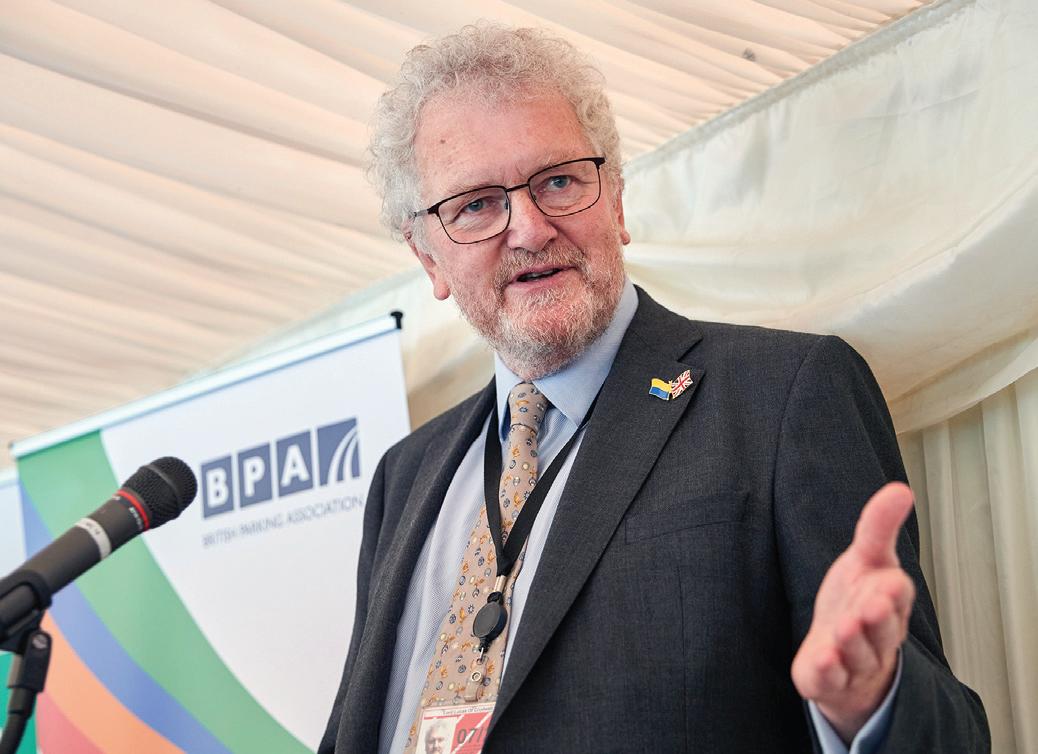


Book now as you won’t want to miss this years members’ dinner, our black tie event at the historic Drapers’ Hall in London on the 29 th November.
britishparking.co.uk/events
 GOLD
GOLD
The British Parking Association (BPA) has commissioned research and published a report to better understand and address issues relating to equality, diversity and inclusivity (EDI) in the parking workforce.

The research, which was conducted by Blue Squirrel Research, used a mixed methods approach of both quantitative and qualitative research tools in order to fully understand the issues faced around EDI and provide an accurate profile of the UK parking sector.
The BPA Equalities, Diversity and Inclusivity (EDI) Research Project 2023 reveals that a large proportion of respondents see the benefits of EDI as being both internal to the sector, through fair and balanced progression, as well as delivering benefits to customer experience, through the more diverse skills and experiences that EDI brings.
Respondents made a range of suggestions made for improvements in the parking sector on a number of different themes including knowledge and training; perceptions of the sector; good practice – what exists and what can be improved; diversity; data; and the impact of training in the sector.
Andrew Pester, BPA chief executive, said: “The report’s recommendations will be invaluable in helping to inform future BPA policy in relation to EDI and ensure that activities are undertaken that support and promote diversity and inclusivity within our governance and the wider parking community. We will harness the findings of this research to inspire and enable a culture of inclusion and diversity, promote and provide career opportunities and encourage continuing professional development (CPD).”
BPA members can download the full report at: www.britishparking.co.uk/EDI-Research
10%
8%
Out of 331 respondents to the online British Parking Association EDI survey:
• 51% male
• 47% female
• 16% non-heterosexual
• 10% neurodivergent
• 8% were disabled.
Respondents were asked what they thought about a career in the parking sector, what more the sector could do to increase equality, diversity and inclusion, and the benefits of increased equality, diversity and inclusion.
• 32% said it was an interesting, varied job, but people have a negative image of parking
• 19% said a parking career offered a wide range of opportunities, but these need to be better communicated
• 36% thought there should be better communication of EDI in the sector
• 40% thought increased EDI would bring a balanced approach to job progression, where everyone is treated on merit.
The British Parking Association has launched a new benefit for its members. BPA Advance offers both corporate and individual members access to a suite of more than 700 online training and CPD modules via the BPA Advance Skills Hub.
The hub offers training in bitesize format on a wide range of subjects relevant to the parking sector. It also covers Approved Operator Scheme (AOS) mandatory training.
BPA Advance also encompasses the association’s mentoring scheme, advice on career progression, webinars and e-zines, access to a Wellbeing Hub, and access to networking events.
16%
47%
51%
64% of authorities have a parking strategy
21% of authorities are planning to develop a parking strategy
15% of authorities have no parking strategy and no intention of creating one
Councils are open to using technology and harnessing data to deliver their parking policies, reports Local Government Information Unit
The majority of council decision-makers lack awareness and understanding of potential changes to local authority parking. This is the key finding in a new report, Parking Strategies and Innovation, from the Local Government Information Unit (LGIU), based on a survey of over 100 councillors and officers. The LGIU is a not-for-profit, non-partisan membership organisation. The unit prepared and distributed a survey to local authority parking decision-makers across England. Responses were received from 108 authorities.
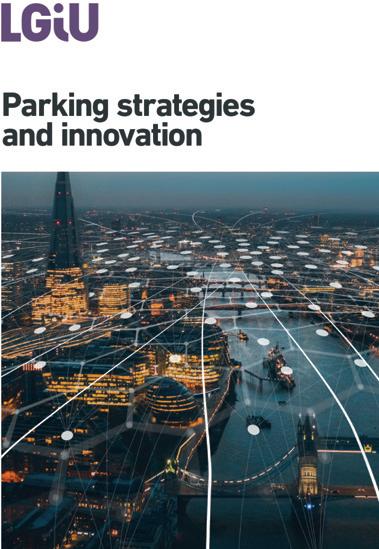
The survey sought views on the future of parking, as well as comments on existing parking policies and operations. Reducing congestion was the most popular objective key priority for local authorities to emerge from the survey. Other priorities included improving road safety, promoting electric vehicles (EVs) and prioritising different types of parking. The survey reveals:
• Overwhelming support (85%) was for EV charging to be integrated with a parking app and for real-time occupancy data.
• 25% of authorities provide real-time information on parking occupancy in car parks, and another 11% intend to do so. Where authorities are planning for this, they intend to provide real-time occupancy information via an app, and it seems this will be the model increasingly adopted, avoiding the high capital costs of roadside signs.
• 95% of authorities have an app or mobile phone-based payment system, with all respondents offering multiple methods of payment to motorists and 86% still supporting cash payments.
Jonathan Carr-West, chief executive of LGIU said: “We understand that parking is a complex issue that cuts across social, economic, environmental and development policies. As driving has become a divisive topic, councils tread a fine line in prioritising the needs of residents, businesses, visitors and different user groups, while
meeting other strategic goals, such as net zero targets.

“New developments and innovations like the National Parking Platform (NPP) have the potential to transform procurement of parking by opening up the market and giving choice to the individual motorist for the first time. In doing so, it could bring significant benefits to local authorities, including cost savings from lowered procurement costs. Our latest report found that a significant number of local authorities in the UK have a strategy gap, which could prevent them from realising the benefits of some of these innovations. We encourage the government to spearhead an awareness-raising initiative around the platform to ensure that local councils understand the NPP and can make an informed decision on shifting to a parking hub.”
As use of income from fines has to be spent first on parking enforcement or provision, the main policy objectives of enforcement has long been compliance with existing parking rules and demand management. The LGIU survey found that local authorities are increasingly widening their objectives, using restrictive parking policies to support net zero air quality through lowered emissions or active travel. Councils can also use ‘permissive’ parking approaches to support economic vitality in town centres and high streets, EV charging points, the mobility of disabled persons or other objectives such as suspended on-street parking fees for health workers during the pandemic.
The survey found that the objectives of parking strategies, where they existed, varied widely. The LGIU notes that just over a quarter (25-30%) focussed on traditional objectives, like providing more parking and reducing congestion, while others embraced integrated and digital approaches to manage traffic and to promote lower emissions vehicles.
Council approaches often combine ‘carrot and stick’, such as restricting parking and vehicle access while moving cars to the peripheries of built-up areas and providing alternative means of transportation. The ability to fine-tune parking and other vehicle or transport charges will also need to be carefully monitored for equity issues across gender and disability and other domains.
The LGIU observes that parking is often used as a policy lever to shift behaviour, particularly on the route to net zero. One council said, in the longer term, their aspiration is that future strategy will encompass dynamic pricing and occupancy charges.
The parking sector is evolving as technology becomes more advanced and ubiquitous, and councils can take advantage of a broader choice of operating models. The LGIU found councils have sought to iterate parking provision via: the provision of electric vehicle (EV) charging stations as part of the parking fee; offering the option for onward travel through public transport or bike or scooter hire; providing incentives to car share; or even the replacement of parking spaces with bicycle hangers to provide cycle storage for urban residents.
New technology developments, such as the Department for Transport-funded National Parking Platform, are also likely to impact the way that local authorities procure and deliver parking services in the future, reports the LGIU.
All the survey respondents were interested in getting better access to parking data to help inform policy making. This could be facilitated and accelerated by the transition to an open market in phone-based cashless parking payments, suggests the Local Government Information Unit.
Looking into the future, the Department for Transport’s vision for parking management is much broader. Further developments could include: the service providing a more comprehensive information source, the ability to implement dynamic pricing; enabling convenient payments for multiple services (including EV charging); integrating with MaaS (Mobility as a Service) platforms, thus aligning with kerbside strategies and optimising data analysis for a deeper understanding of the market.
The LGIU suggests that a multi-pronged approach, supported by readily available data, was appealing to a number of its interview respondents who could see the potential for parking as ‘multi-use spaces’ with areas becoming ‘mobility hubs’ rather than simply a place to leave a car.
The Local Government Information Unit’s Parking Strategies and Innovation report was launched at the All Party Parliamentary Group (APPG) at Local Government’s summer reception in the House of Commons on 18 July. The APPG’s chair, Chris Clarkson MP, introduced guest speakers local government minister Lee Rowley, LGIU chair Cllr Michael Payne and Peter Driscoll, managing director of RingGo, which supported both the report and reception. lgiu.org
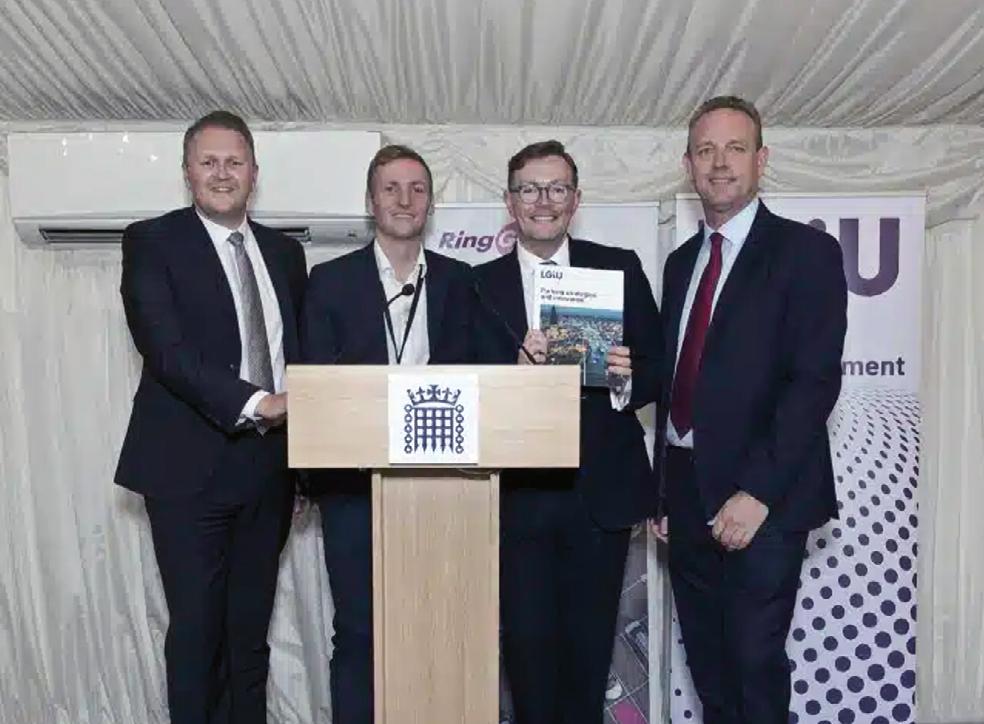
The Department for Transport (DfT) is expected to move the National Parking Platform (NPP) from its trial phase to fullscale national roll out during 2024. The NPP will enable approved phone parking providers to integrate their services and access all available parking inventory in a specific geographical area, without needing to go through the current tender process.
Although 64% of councils have a parking strategy in place that outlines their development plans, the Local Government Information Unit (LGIU) report Parking Strategies and Innovations has identified significant gaps in understanding about the new model, which will impact the future-proofing of these strategies. The survey found that:
• Over a third (36%) of respondents had never heard of the NPP
• 44% of respondents said they had not heard of the open market model which will introduce competition
• almost 80% said they would welcome efforts by the government to explain more about how the NPP will work in practice.
The platform is publicly owned, which aligns with the survey findings: 44% of local authorities prefer this model, while only 3.5% favour a private-sector hub.
The LGIU survey was part-funded by cashless payment provider RingGo, which is an advocate of the NPP and an open market approach to phone parking provision. Speaking at the House of Commons launch of the LGIU report, Peter O’Driscoll, managing director of RingGo, said: “The NPP provides the foundation for the open market in parking, which allows multiple phone parking providers to operate alongside each other. This will encourage competition between parking providers and enable motorists to choose their preferred parking app.”

Currently, 86% of councils working with phone parking providers contract them through a tender process. This limits motorists to one service provider per area. According to the LGIU survey, only 30% of councils said the current procurement model is either cost or time efficient. O’Driscoll said: “An open market model significantly reduces or removes these challenges, while improving service resilience and incentivising innovation. It is already a standard model used across much of Europe and solves the problem of drivers having to download multiple parking apps to pay for parking. This approach is strongly supported by local authorities: 83% of survey respondents favour downloading only one app.
“The NPP has the potential to benefit every council. They would be able to move away from a time-consuming and costly procurement process, while offering motorists more choice. The preliminary trial in Manchester, and Cheshire West and Chester indicates it creates a competitive market, with parking sessions spread across multiple phone parking providers. With towns and cities under pressure to improve and integrate services and reduce emissions ahead of net zero targets, now is the time for the NPP and the open market. We look forward to the government moving decisively to scale the platform as we work together with local authorities to make our cities more liveable.”

Car park design needs to evolve to cope with bigger, heavier electric cars and better reflect 21st century social and environmental issues. These are among the key messages in new guidance published by the Institution of Structural Engineers (IStructE).
Car Park Design covers the design, construction and asset management of all car park structures, including standalone multi-storey car parks, underground car parks and those within buildings with other uses such as office, residential and retail. It is designed to serve as a resource for car park architects, engineers, developers, funders and those who service and maintain these facilities.
IStructE first published Design Recommendations for Multi-Storey and Underground Car Parks in 1976, and over four editions it became an essential reference book for designers. While building on this legacy, Car Park Design is a completely new book that addresses a range of issues such as vehicle sizes and weights, fire safety, accessibility, electric vehicle charging and what to do with a structure when its life as a car park comes to an end.
Mark Pundsack, chair of the contributor group and Fellow of the Institution of Structural Engineers (FIStructE), explains: “As we move to using more electric or hybrid cars, we are now exposed to risks from vehicle compositions and propulsion systems which current design guidance does not acknowledge. We have moral and legal duties to make buildings accessible for all — and car parks are no exception.
“The car parks built today, or those being renovated and re-used, need to be designed with all this in mind if these structures are to remain viable and useful in a rapidly changing world.”
A panel of ten experts contributed to the guidance including overseeing consultant Chris Whapples, a Fellow of the Institution of Structural Engineers (FIStructE).

The other authors were: Peter Guest, Dan Gullock, Alan McBryan, Fiona Petch, Peter Robery, Russell Simmons, Jeff Stewart and Chris Watkins.
Ensuring car parks are structurally sound is essential, says Chris Whapples: “There are myriad considerations the design of a modern car park needs to address, particularly as selling petrol and diesel cars and vans will be banned in the UK by 2030, and hybrid cars and vans by 2035. Car park safety is paramount, especially given the learnings from structural failures, including the Pipers Row floor collapse in Wolverhampton, UK in 1997. And this guidance is made increasingly relevant with the recent, tragic collapse of a car park in Manhattan, New York, which is currently being investigated.”
The book is spilt in two parts: • Part one is aimed at those involved in procuring a car park, including clients, architects, and project managers among others.
The Institution of Structural Engineers has published a comprehensive guide to contemporary car park design
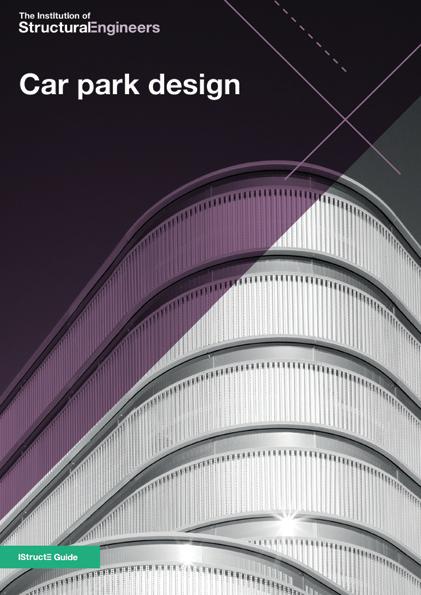
size of cars increasing. This extra load and the changing fire safety requirements are all considerations not just for new car parks, but for existing structures too.
• Part two covers more in-depth design issues, with detailed recommendations for those responsible for inputting to the detailed design such as structural and civil engineers.
Car Park Design highlights that a number of serious fires have happened in car parks which were designed to current guidance, and that in certain circumstances, this may not produce a fire-safe design.
The guidance explains that new car parks need to be designed to handle changes in car design. Many existing car parks across the country were designed when cars were smaller and fitted with less technology. The guidance states that car parks in the UK need to evolve to cope with bigger and heavier cars such as SUV and electric vehicles.
The average vehicle’s weight has risen from 1.5 tonne in 1974 to almost 2-tonnes –due to electric and hybrid batteries and the
The guide also advises that the design, construction, maintenance and reuse of car parks will also need careful consideration given their purpose is changing from just parking cars to recharging and storing them, alongside e-bikes and e-scooters.
Accessibility is an essential part of the design process, given that in the UK and many other countries people are living longer, with more independence. The physical impairments of a greater number of car park users therefore need to be addressed.
The institution’s guidance dedicates a chapter to the often-overlooked mental health aspects of car park design, with important consideration given to the various physical measures that can be part of the building to deter suicide attempts.
Car Park Design
www.IStructE.org

There are myriad considerations the design of a modern car park needs to address Chris Whapples
A multi-storey car park planned as part of a Manchester regeneration project has been redesigned in an effort to make the development more sustainable. It is three years since the Mayfield plans were first approved, prompting a refresh of the original proposals.

The Mayfield Partnership has now submitted an updated planning application for the £400m first phase of the wider £1.5bn scheme. The partnership comprises LandsecU+I, Manchester City Council, LCR and Transport for Greater Manchester.
The updated plan comprises two office buildings, the car park and three acres of public spaces in addition to the £23m Mayfield Park, which opened last year.
The planning application submitted to Manchester City Council seeks permission for a raft of changes to the car park, which has been designed by Studio Egret West.
The number of parking spaces has been reduced from 581 to 487. A planning statement prepared by Deloitte says the bay reduction reflects the inclusion of new active uses within the ground and basement levels of the car park as well as removal of one half-deck of spaces.
Changes include the creation of 450 cycle parking spaces at basement level and an additional 14,000 square feet of commercial space on ground floor level.
There will be more electric vehicle charging points when the car park opens. The site will also have the capacity to allow
50% of all spaces to have EV charging capability. A rooftop solar array is another new addition to the plans.
The proposed exterior of the building has also been given a makeover. Deloitte states the

updated designs better reflect the history of the Mayfield area. The upper levels of the car park now reference patterns from the Calico Dye Works that formerly occupied the site.
The redesign has allowed the


developer to rethink the opportunity for the building to be repurposed in future. The upper levels of the car park will be demountable and sit above a two-storey concrete plinth forming the basement and ground floors. This means the car park element can be removed and the foundations reused.
The Poulton and The Republic, the first two office buildings planned for Mayfield, have been reworked with a target of 600kg of CO2/square metre. The developers are aiming for a 5.5-star NABERS energy efficiency rating across both buildings. Bennetts Associates designed The Poulton, a 76,000 square foot building, and Morris+Company is behind The Republic, a 244,000 square foot development.
A plan to convert the upper floors of a Birmingham multi-storey car park into an urban farm have been approved.
Sustainable food producer Slow Food Birmingham will redevelop levels five and six of the Vyse Street car park in the Jewellery Quarter. Vegetable plots, greenhouses and gardens will take up the space, with a focus on community use as well as food production.

Slow Food plans to collect rainfall to water plants and cover flat spaces on the top floor with wind turbines.
The scheme has met with opposition. Birmingham City Council received an online petition objecting to the loss of 39 parking spaces received more than 500 signatures. There were also six letters of objection about the loss of parking provision and complaints that jewellers would be squeezed out of the area.
Five letters of support were also sent to the authority, praising a scheme seen as offering much-needed access to green space in an urban area.
Structural engineers say High Street car park should be demolished
The High Street car park in Bracknell is to close following surveyor reports that show the structure is corroding and is beyond repair.
Bracknell Borough Council’s executive has agreed to close the 1970s car park, which is currently safe to use, within the timescales set out by structural experts.
Use of its middle parking bays has been suspended to spread weight load. This provided a temporary solution that enabled the car park to remain open.
However, the surveyors advised that this cannot continue as the structure is corroding. They recommended closing the car park before the end of the year as the level of corrosion within the concrete reinforcement cannot be remedied.
High Street will remain open safely until 31 October. Work will then begin to safely hoard off the car park in November.
The site will be added to the overall town centre masterplan for regeneration.

High Street car park is mainly used by council staff working in the nearby Time Square office and a handful of monthly season
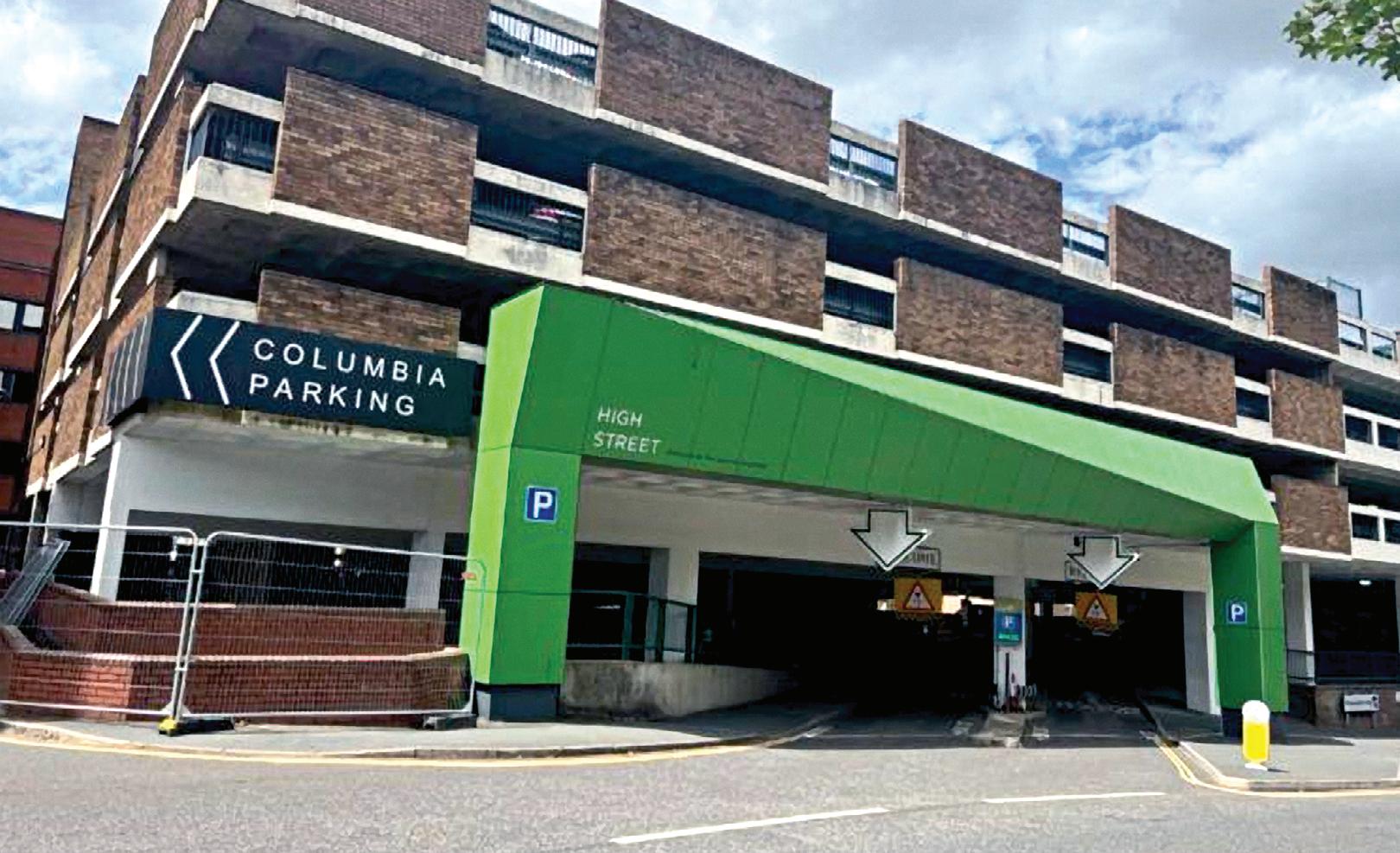
ticket holders. It is not the car park of choice for shoppers or those visiting The Lexicon.
Alternative car parks in the town centre include Braccan Walk, Princess Square, Albert Road and Weather Way.
It is not expected that closure of High Street car park will impact on people’s ability to park as only The Avenue car park reaches capacity at Christmas peak times.
The structural engineers have advised that the businesses under High Street car park could remain in place safely until 2025,
subject to regular inspections.
Discussions are ongoing between the council, Bracknell Regeneration Partnership and Shopmobility to find an alternative parking and drop-off point for people that use Shopmobility.
Kevin Gibbs, executive director for delivery, said: “High Street car park is currently safe to use but independent structural experts have told us that it is corroding and there is no way to fix it.
“The safety of car park users must be our priority, which is why the executive has agreed to
Plans to improve facilities at Northampton railway station by building a new 1,198-space multi-storey car park have moved forward.
West Northamptonshire
Council approved proposals at the cabinet meeting on 13 June. The council is working with Network Rail and its development partner BlocWork to bring forward the new car park, which will increase capacity at the station from 800 to 1,200 bays.
Following cabinet’s approval in December 2021, plans have altered while the council has responded to lasting impacts of the COVID-19 pandemic, war in Ukraine and cost inflation.
The terms of a lease on the car park were not agreed so the council stepped in to deliver proposals which will allow West Northamptonshire manage the facility. The council
said this will offer best value for money for residents.
Cllr Dan Lister, cabinet member for economic development, town centre regeneration and growth, said:
“There is a real need for a new multi-storey car park to replace the current arrangements which currently exist at Northampton railway station. By creating a multi-storey car
park we can make space available for future development which will further enhance this area.
“Over the last 18 months we have been closely monitoring the vast increase in inflation and responded to the effects of the pandemic and are now in a strong position to bring forward this development and manage the facility in-house.”
close the car park at the end of October – in line with expert advice. The simple issue is that the car park was built more than 50 years ago when vehicles weren’t as heavy. The weight load of heavy, modern vehicles has put considerable pressure on the structure.
“It will remain open until 31 October, which will give us time to look in to an alternative dropoff point for Shopmobility users and let everyone who uses it know that they will need to find an alternative car park from 1 November.”
Essential maintenance work is being undertaken at a multi-storey car park in St Helier on the Channel Island of Jersey.
The 750-space Patriotic Street car park will remain open during the works, with no more than three of 12 floors closed at any one time.
The Government of Jersey said the first phase of the maintenance works would run through until 10 November.
The works include adding new pedestrian routes, general repainting, replacement of fencing, minor concrete repairs and repainting of steelwork.
The island’s government said parking for the nearby Jersey General Hospital would not be affected by the project.
Urgent action is needed to improve climate resilience in urban areas as extreme weather conditions become a more frequent occurrence.
It is beyond dispute that laying down swathes of concrete will exacerbate flooding by causing run-off. Alternatives are needed to blacktop, either through more green infrastructure or permeable surfacing.
These issues will be discussed at the inaugural Climate Resilient Streets.
The conference is designed for planners and engineers working at local authorities, along with urban planners and landscape architects, landowners and developers, water and flood management professionals.
Climate Resilient Streets will cover:
l The latest green + blue innovations
l The virtuous circle: how green infrastructure will encourage modal shift
l Co-designing schemes with communities
l How to ensure that schemes are maintained with support from communities
l Developing multi-disciplinary partnerships to implement the right schemes

l Why green infrastructure is good for local economies
l Multi-functional infrastructure: Water as an asset rather than a liability
l Identifying new funding sources – making use of asset renewal budgets, S106 etc
l How monitoring can prove that rain gardens alleviate the impact of flash floods
www.landorlinks.uk/climate-resilient-streets
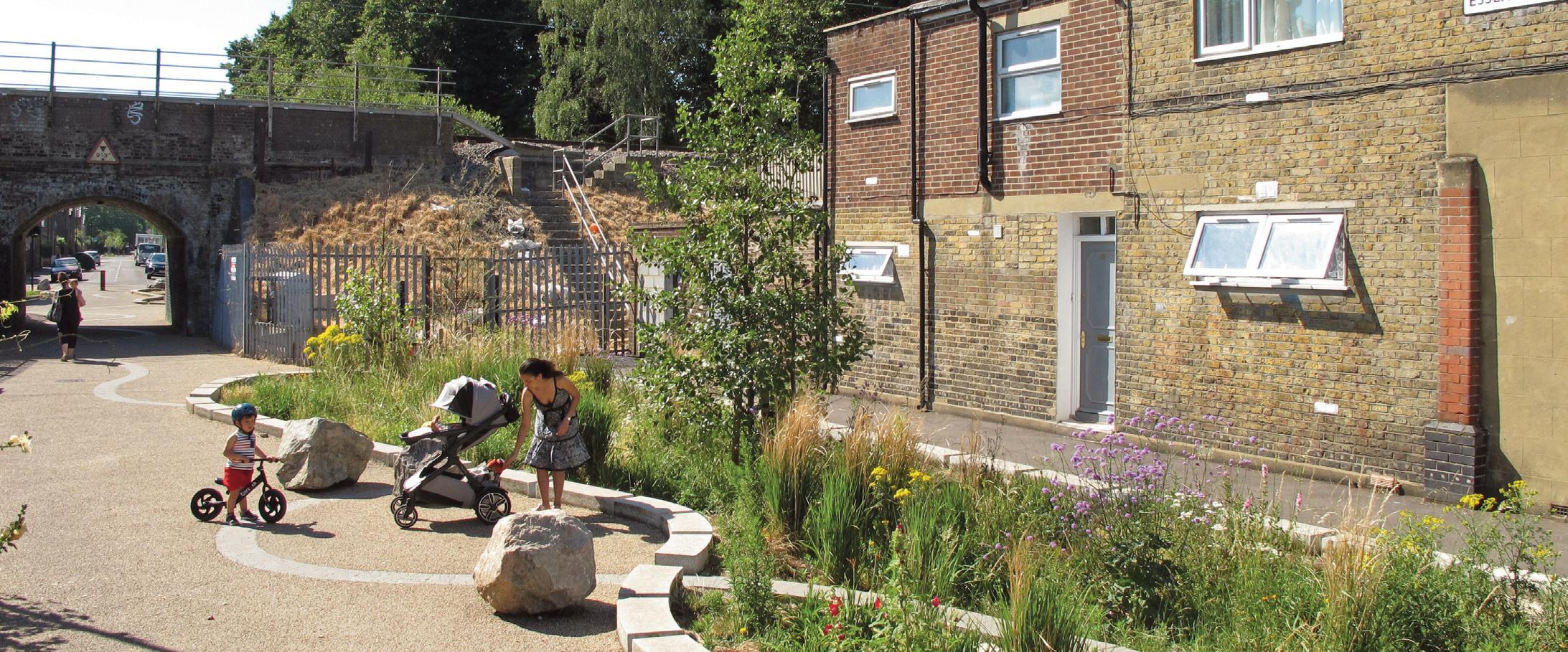 Sponsored by:
Organised by:
Turning the grey green
To suggest a paper or speaker opportunities, please contact Deniz Huseyin - deniz.huseyin@landor.co.uk
To discuss exhibition & sponsorship opportunities please contact Daniel Simpson - daniel@landor.co.uk
Sponsored by:
Organised by:
Turning the grey green
To suggest a paper or speaker opportunities, please contact Deniz Huseyin - deniz.huseyin@landor.co.uk
To discuss exhibition & sponsorship opportunities please contact Daniel Simpson - daniel@landor.co.uk
Fires in multi-storey and underground car parks present a number of serious challenges to designers, operators and firefighters.
Dangers include the spread of flames between vehicles, the build-up of smoke and the difficulties of fighting a fire in an enclosed area. The manner in which petrol and diesel vehicles burn has been studied over decades and is reflected in design guidance, but the fire safety implications of electric vehicles (EVs) and their associated charging infrastructure present new design and operational challenges.
To help car park operators, designers and risk assessors make car parks safer in the electric motoring age, the Office for Zero Emission Vehicles (OZEV) has published new fire safety guidance for parking and charging electric vehicles in car parks.
The advice has been drafted by consultant Arup in consultation with fire safety groups, car park operators and the chargepoint sector. It outlines fire safety considerations and measures to take when: retrofitting existing covered car parks for the provision of electric vehicles and electric vehicle chargepoints; or designing new covered car parks for the provision of EVs and chargepoints.
The guidance has ‘interim status’ because it is based on currently available research and evidence surrounding EV fires, which will continue to develop. It is based on a review of the literature and global data in relation to EV fires available as of April 2022, as well as stakeholder consultation and UK government data for vehicle fires up until the third quarter 2022. This means it is subject to change should new evidence emerge that significantly impacts appropriate mitigation measures. It does not replace existing safety regulations or the need to comply with them.
Covered Car Parks: Fire safety guidance for electric vehicles uses the term ‘covered car park’ for consistency with Approved Documents which cover infrastructure for charging electric vehicles under the Building Regulations, and encompasses open-sided and enclosed car parks.
The guidance considers road passenger battery electric vehicles, meaning it focusses on cars and vans only. It does not consider other forms of electric transport such as hybrid electric vehicles (HEVs), plug-in hybrid EVs (PHEVs), electric bicycles or electric scooters, electric buses or other utility vehicles.
A fire starting in the battery of an electric vehicle has a different fire behaviour compared to an internal combustion engine (ICE) vehicle fire, as the battery can undergo a phenomenon known as ‘thermal runaway’ and is influenced by factors such as size of battery, battery chemistry and state of charge.
Thermal runaway is a process within
battery cells which leads to the decomposition of battery elements and can lead to the onset of fire within the battery.
The review reveals that there are both similarities and differences between EV and internal combustion engine vehicle (ICEV) fires. Some of the different risks associated with EVs include:
• reignition as fires which involve a vehicle battery can reignite hours or days after the initial fire burned in a process called thermal runaway

• compressed gas venting causing jet flaming or vapour cloud explosions –compressed gases can vent from a battery and if ignited can result in flash fires or directional jet flames, alternatively compressed gases can vent from a battery, and if accumulating in a confined space at the right mixture could result in a vapour cloud explosion (VCE).
Suppressing a fire involving the battery requires different firefighting techniques and equipment and can take longer and in some instances may not be feasible until all flammable material has burned. The battery material and smoke produced when involving the battery can be more toxic, which contaminates firefighting water run-off.
The interim guidance document reviews the hazards that could lead to a fire within an EV parked in a covered car park; and, within an EV whilst charging within a covered car park. For each hazard, mitigation measures are considered which could reduce the likelihood of a fire occurring involving an EV.
The document considers what mitigation
measures could be introduced to minimise the impact of a fire on the occupants, the fire service, the car park structure, other vehicles, adjacent buildings, and the environment.
Mitigation measures are ranked using the ERIC (eliminate, reduce, isolate, control) hierarchy.
Arup’s review states that available empirical evidence to date suggests that fires in EVs are less likely to occur than in hybrid vehicles and petrol or diesel vehicles. However, this will need to be monitored as fire risk may increase as cars age, and as EVs become more affordable to a wider range of drivers.
The guide provides two case studies, one for existing basement car parks where EV chargepoints were installed, and a new multi-storey car park that is future-proofed for 100% chargepoint coverage.
The guidance acknowledges different measures to mitigate an EV fire:
• mitigation relating to electrical, mechanical and thermal abuse
• increased preventative methods such as crash protection for chargepoints; thermal monitoring cameras; and watersuppression methods
• consideration for spacing
• consideration for ventilation.
The document advises that car park owners and operators should carry out a fire risk assessment to determine whether the introduction of EVs or chargepoints into their car park creates new or additional hazards and whether any of the mitigation measures discussed within this document could be implemented.
Public EV charger provision has grown 10% since April, reports Department for Transport
There are now over 44,000 public electric vehicle charging devices installed across the UK. However, new figures released by the Department for Transport reveal the geographical distribution of charging devices remains uneven, with London and Scotland being the most well served.
As of 1 July 2023, there were 44,020 public electric vehicle charging devices installed in the UK. Compared to 1 April 2023 the total installed devices increased by 3,870, an increase of 10%.
The number of rapid charging or above devices increased by 814, an increase of 11% over the past six months.
Charging device location categories are defined based on both the physical and, or type of facility they are located in and who can access this but also the type of charging service they are designed to deliver.
Since 1 July 2022 the number of installed public devices has increased by 12,009, a 38% increase. The number of rapid charging or above devices increased by 42%, an additional 2,487 public devices installed.
Proportionately, the largest increase in installations in the last quarter was within the ultra-rapid device category, which increased by 29% (albeit from a lower base than other categories), accounting for 776 charging devices. Ultra-rapid charging devices are still the smallest overall category with 3,437 devices.
Proportionately in the last quarter, the smallest increase in charging device installations was in the rapid charging devices categories, with an increase of 1% or 38 charging devices. Fast charging devices are still the most common category to be publicly installed. The most common location category for charging devices is ‘Destination’ with 21,294 charging devices or 48% of all publicly available charging devices. “On street” charging devices account for 34% of charging devices or 14,848.
There is an uneven geographical distribution of charging devices within the UK. Some UK local authorities have bid for UK government funding for charging devices, and others have not. Most of the provision of
• On Street Charging devices located on residential streets only.
• En-route Charging devices located for charging to continue a journey. Located in motorway service areas, service stations, electric forecourts and ferry terminals. Additionally rapid or ultrarapid devices in hotels, restaurants and attractions.
• Destination Charging devices located at the end of an EV journey or where a driver may typically stop for an extended period of time. Consists of devices located in retail car parks, car parks, leisure, education areas, hotels, restaurants and transport (except ferries).
• Other Charging devices are semipublic with some level of access restrictions such as workplace car parks and dealership forecourts.
this infrastructure has been market-led, with individual charging networks and other businesses (such as hotels) choosing where to install devices.
London and Scotland had the highest level of charging provision per 100,000 of population, with 152 and 73 devices per 100,000 respectively. In comparison, the average provision in the UK was 66 per 100,000.
Northern Ireland had the lowest level of charging device provision in the UK, with 23 devices per 100,000, followed by the North West and East Midlands with 39 and 43 devices per 100,000 respectively.
Scotland had the highest rate of rapid device provision of 19.2 rapid or quicker devices per 100,000, whilst the average provision in the UK was 12.6 per 100,000. Rapid or quicker device provision was lowest for Northern Ireland with 3 rapid or quicker devices per 100,000. North West and London were the second and third lowest regions with 9.9 and 10.7 rapid or quicker devices per 100,000 respectively.
All regions across the UK saw an increase in total charging devices between April to June 2023. East of England had the greatest increase at 26.1%, whilst Scotland had the smallest increase at 1.7%. East of England had the greatest increase in absolute number of devices at 652 devices, followed by London at 591.
Rapid charging or above devices have increased in every region in the UK. The smallest percentage increase in the number of rapid charging or above devices was London at 4.3%. Northern Ireland had the largest percentage increase in rapid charging or above devices at 54.1%, corresponding to an increase of 20 rapid charging or above devices.

kerbside EV chargepoint network online. Factors that Etc. will study include:
The transition from petrol and diesel vehicles to electric models will require a substantial increase in the provision of public chargepoints. The provision of charging infrastructure at the kerbside is a challenge that has seen the emergence of initiatives such as adding chargepoints to lamp columns. There are now proposals to make use of other pieces of existing street furniture with mains power supplies as locations for charging points.
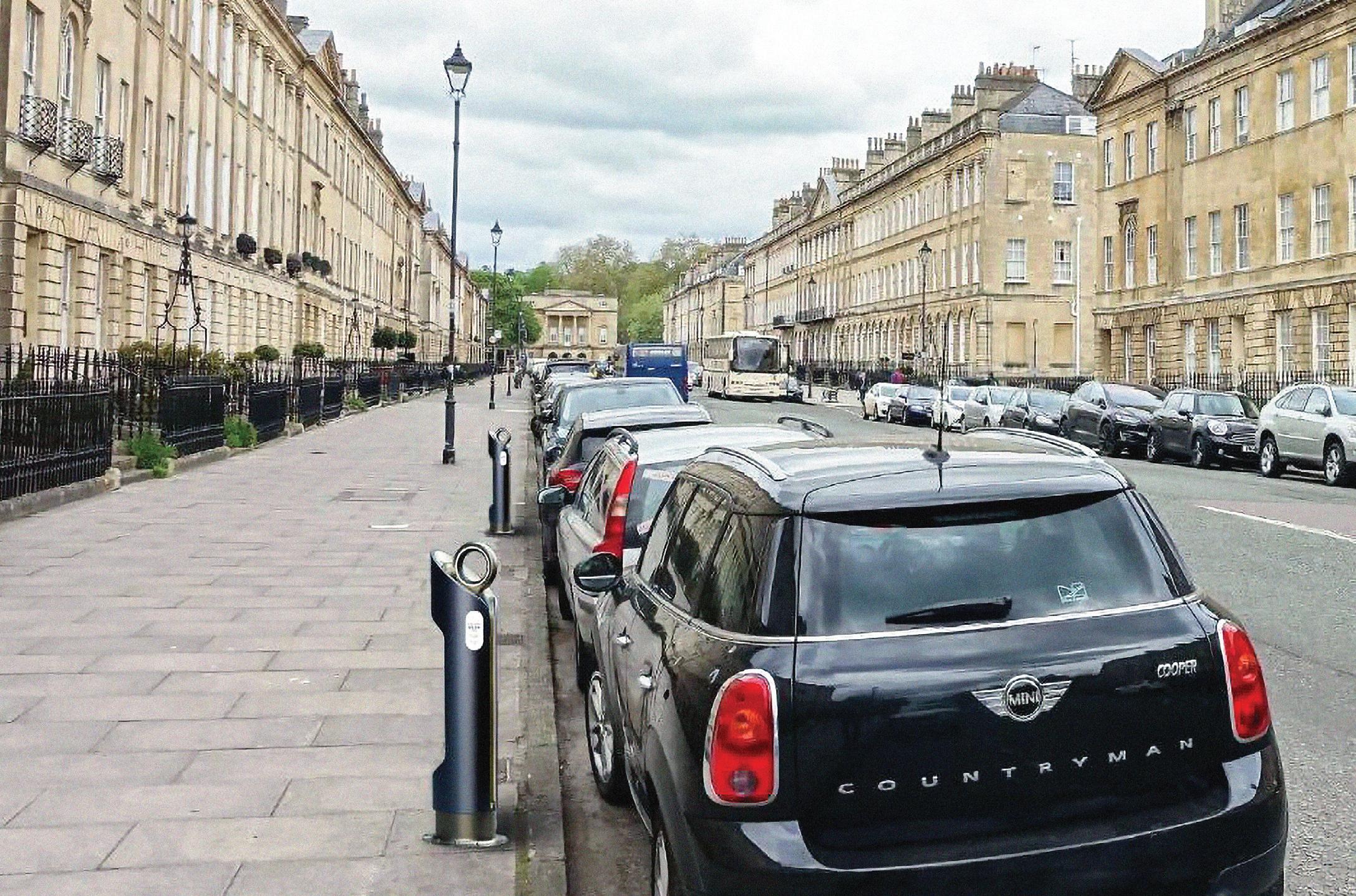
Telecommunications company BT is to pilot repurposing redundant street cabinets as EV charging units. The cabinets are currently used for providing copper-based broadband and phone services, and will be decommissioned as the nationwide upgrade of the telecom network to full fibre progresses.
BT’s digital incubation team, known as Etc., will run the pilots. The two-year trial will focus on both technical and commercial aspects of converting street cabinets. The pilots will provide insight into the viability to scale EV charging to more locations across its estate. Etc. estimates that up to 60,000 of BT Group’s 90,000 cabinets could be suitable for upgrades to EV charging points
The study team will scope a range of different technical, commercial and operational considerations with bringing a potential
• Technical: cabinet location, power availability, customer accessibility, digital customer experience and engineering considerations
• Civil planning: location, local council engagement and physical accessibility
• Commercial: public funding options, private investment, partnership, and wider financial modelling
• Operational: a dedicated BT Group venture or in partnership with others.
The Etc. project involves collaboration across the BT Group to assess the potential in this sector and test the technology. The first phase of the EV charging pilots, open to Openreach and BT Group colleagues, will kick off in Northern Ireland in Autumn 2023. The programme will be expanded to the public as more locations are added across the UK later in the year.
The UK government has announced an ambition to grow the number of UK chargepoints from around 45,000 today to 300,000 by 2030, committing £1.6bn in public funding to the effort. Forecasts for the public EV charging sector are evolving rapidly as consumer habits shift ahead even of the 2030 deadline for the end of internal combustion engine vehicle sales, but estimates generally see it climbing to be worth multiple billions of pounds by the early 2030s.
“With the ban on sales of internal combustion
engine vehicles coming in 2030, and with only around 45,000 public chargepoints today, the UK needs a massive upgrade to meet the needs of the EV revolution,” says Tom Guy, managing director, Etc. at BT Group. “We have a once in a lifetime opportunity to connect for good in a whole new way by innovating around our cabinet infrastructure. The pilots are critical for the team to work through the assessment and establish effective technical, commercial and operational routes to market over the next two years.”
Ben Nelmes, chief executive of business analyst New Automotive, sees merit in the concept of repurposing street cabinets. He said: “The need for more EV charging represents an exciting business opportunity, so it is great to see BT Group announcing plans that could play a key role in growing the number of chargepoints and helping enable more people to make the switch to an electric car.”
The BT project has also been welcomed by the Climate Group, an international non-profit organisation with a mission to drive climate action. Helen Clarkson, chief executive at Climate Group, said: “We’re seeing more and more ambitious commitments from corporates to grow their EV fleets in the coming years. Programmes like BT Group’s are an incentive for other businesses and drivers to go electric. But we need the UK government to play its part – wider availability of chargepoints right across the country, not just in London, will help build confidence that switching to an EV is the right option.”

When it comes to electric vehicle charging, hospitals and university campuses face similar opportunities. Both have large parking estates, with a wide variety of users, from fleets of vehicles, to staff and students, to patients and visitors. Both are organisations expected to lead the way in socially beneficial initiatives. And both could benefit from extra revenue.
The NHS has 500,000 parking spaces and 1.27 million employees, and half of trusts already have EV charging infrastructure onsite, with most of the rest planning to. The British Parking Association (BPA) estimates there are nearly 300,000 car parking spaces across the UK university sector.
Deploying charging can have three big benefits:
• EV charging can burnish their eco credentials, making them attractive places to work and study
• EV charging can provide a nice staff incentive, and encourage employees without driveways to make the EV switch
• EV charging it can generate revenue. To do that, they need to put the charging infrastructure in, but also set up digital payment systems to make it work well. That means considering all the different use cases.
Fleets may be provided with free charging (obviously emergency vehicles will need a
separate scheme). Staff may be offered subsidised charging as a workplace incentive. That will mean creating an app or RFID card scheme that allows them to identify themselves and access their preferential rate. This may need to be capped at some level.
Then, visitors may pay a standard rate, generating income for the site owner. This would likely be accessed on a one-off or occasional basis by a dedicated app developed by the hospital/campus, a card reader on the charger, or at the parking ticket terminal. Parking could also be bundled into the charge price to enhance the user experience.
NHS trusts and universities may also wish to consider offering the chargers to the general public during quiet times, to maximise revenue. For example, local residents may wish to charge overnight, or a number of spaces could be rented out to an electric taxi firm to charge during certain hours. Payment could either be managed via the downloadable hospital app, or via an integration with apps already used by such groups.
In short, there will be lots of different users, on different tariffs, accessing chargepoints in many different ways, therefore, the ability to offer dynamic tariffs to ensure, for instance, that pricing stays in line with volatile energy prices means that any large-scale chargepoint deployment must look beyond the physical
charger. Digital technologies allow you to manage the payment independently of the charger, so it exists in the cloud. There it can become highly customised to meet varied and changing pricing needs, as well as joined with adjacent services such as parking to provide bundled payments.
It also means that different front-end systems can be linked to it via an API. So, it is easy for hospitals or campuses to build their own app for their needs. But equally existing apps, such as those for local resident scheme apps or student union apps, can be modified to allow users to access these chargers on defined terms. And other digital payment terminals can be linked to chargers via the cloud-based payment platform without the need for complex physical integrations.
The point is that, with so many parts and players involved, it’s important to embrace technologies that can accommodate this complexity, and set yourself up to manage infrastructure that will evolve. The tech buzzword is ‘platform’ – the bit that sits in the middle and makes everything else work.
It is only by embracing this digital world that physical charging infrastructure can deliver for places – such as hospitals and campuses – which need to provide a wide range of user charging experiences.
Sara Sloman is chief strategy officer at Paythru paythru.com
By embracing the digital world physical charging infrastructure can deliver for destinations such as hospitals and campuses
Sara Sloman
Plans to bring a Mobility as a Service (MaaS) platform to the West Midlands have been launched following previous unsuccessful attempts to provide a region-wide system giving everybody access to all transport modes and parking in one place.
Transport for West Midlands (TfWM) envisions MaaS as a means of delivering on aims set out in the region’s Local Transport Plan by building trust through an enhanced user experience, integrating ticketing and information and helping decarbonise the transport network.
TfWM has appointed FOD Mobility Group to help design, develop and deliver the app using its Mobilleo MaaS platform. The FOD system will replace the existing TfWM app.
The new app is seen as a way to boost use of public and shared transport in the region. Wherever the user wants to travel to, the app will give them the most convenient, cost-effective and sustainable option, tailored to their individual preferences.
The app will enable users to plan journeys, receive live travel information, book and pay for all local transport options –including buses, trains, trams, e-scooters, walking, cycle hire, taxis, Demand Responsive Transport (DRT), car rental, car clubs and parking.
TfWM executive director Anne Shaw said: “TfWM is putting unprecedented investment into growing our Metro, rail, bus and active travel networks. As well as developing travel modes, we need to look closely at how we can make accessing transport as seamless as possible through
simple plan, book and pay mechanisms. This will encourage more people to use public and shared transport, or active travel and reduce private car use.
“With this new Mobility as a Service platform we are looking to do just that. We are working with some of the best British tech and mobility companies to design an app which is easy to use, convenient and offers great value. This will be a one stop shop for anyone looking to travel around the West Midlands.”
Transport for West Midlands is part of the West Midlands Combined Authority (WMCA). Led by the Mayor of the West Midlands, the WMCA brings
together 17 local councils to oversee the transfer of powers and funding from Whitehall to the West Midlands.
FOD Mobility Group’s chief executive, Justin Whitston, said: “We are delighted to be working with TfWM on what will be an exciting and scalable Mobility as a Service project, powered by our Mobilleo platform.”

Alongside FOD Mobility Group, TfWM is working with a range of partners including consultants Arcadis, which is providing behaviour change advice, cycle company Brompton Bike Hire and the Enterprise Rent-A-Car and Car Club.
TfWM has revived its ambition to provide a ‘one platform, one account’ travel system despite the collapse of a previous arrangement for a MaaS offer operated by Whim. The Finnish company MaaS Global launched Whim in the West Midlands in April 2018, with its MaaS platform as a series of trial payment packages including public transport, taxi and car hire. However, in early 2019, MaaS Global withdrew Whim due to low uptake.
Parking technology specialist Metric Group has unveiled a Software as a Service (SaaS) solution designed to help local authorities, NHS trusts, universities and car park operators manage all aspects of their parking operations.
Metric Connect is a suite of tools hosted in an integrated cloud-based solution. It aims to streamline processes for users and enable both private and local authority operators to manage notice processing
from end to end.
The service includes PayMyPark, a cashless payment app and website, an enforcement app and back-office notice processing system. The suite also features a configurable permit back-office management module and customer selfservice PCN and permit websites.

Metric says additional benefits include an intelligent automatic workflow system and much more.
Oz Choudhri, head of mobility solutions, UK and Ireland for Enterprise said: “Enterprise already has a strong presence throughout the West Midlands through our rental and car club operations. We are confident that we will further grow this presence, enabling us to play a key role in delivering shared and sustainable transport. We will be working with TfWM on a number of social value projects which will engage with residents and businesses.”
Other project partners include ITO World, which provides realtime public transport data across the West Midlands, and Euclid and Unicard, who are responsible for integration with the Swift smart travel scheme. Local authority and transport operator partners will collaborate on the app development.
The West Midlands MaaS app’s development has been funded from the Department for Transport’s Future Transport Zone programme.
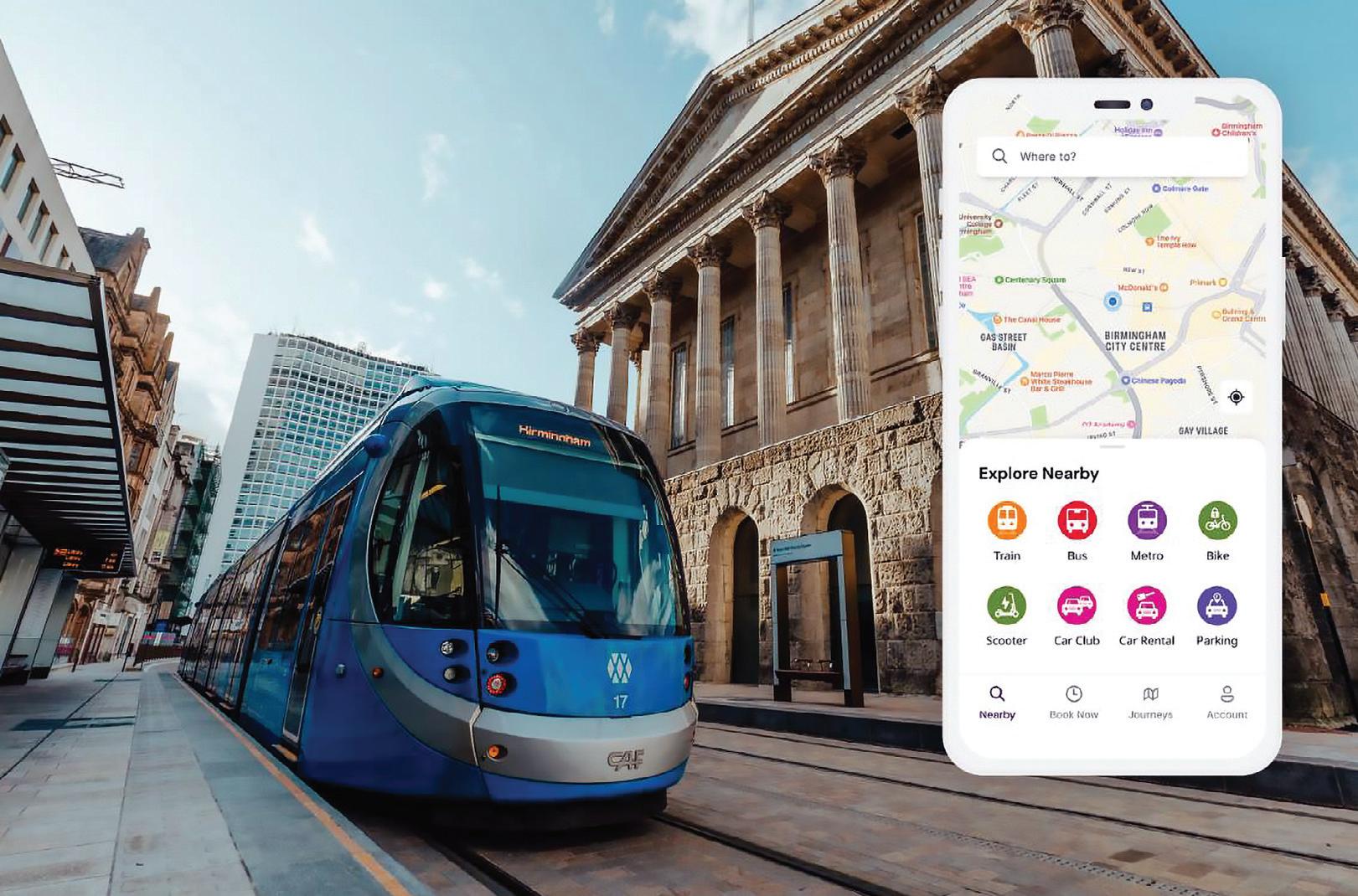
YOUR GUIDE TO CONSTRUCTION, CONSULTANCY, PARKING SYSTEMS, TECHNOLOGY AND RECRUITMENT SERVICES
The Leading Independent Consultancy for all your parking solu琀ons
Established in 1991, with over 230 sa琀s昀ed customers comprising both public and private sector (including Local Authority and Health and Educa琀on establishments). Quality parking solu琀ons provided by our experienced in house specialists:
GIS mapping and surveying
• MTO site surveys and digi琀sing.
• On street TRO signs and lines: legality and condi琀on surveys (sample surveys also available).
• GIS mapping of TRO surveys, produc琀on of digital maps and TRO management for Order wri琀ng, upda琀ng and consolida琀on.
• Data extrac琀on and conversion of text based schedules to digi琀sed map based solu琀ons.
• Length of stay, usage, and occupancy parking surveys, both on and o昀 street.
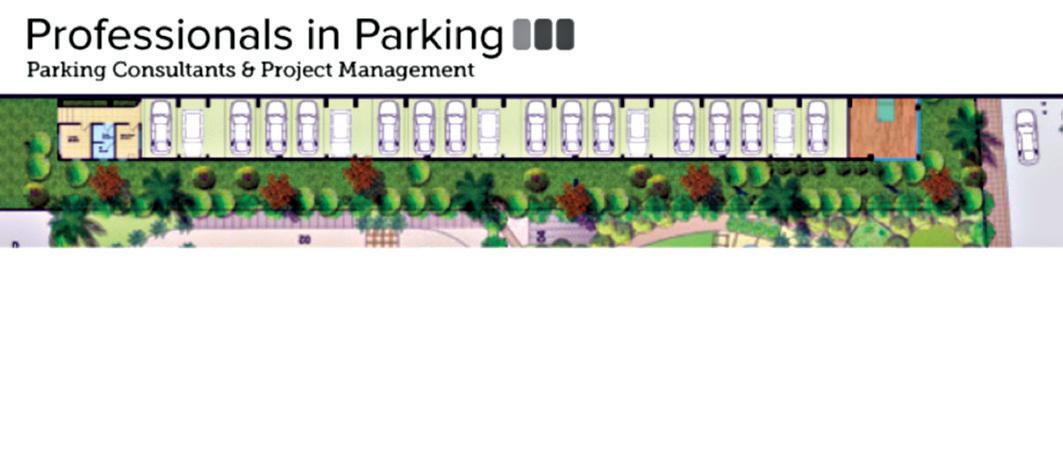
• Compliance surveys and data analysis.
• Surveying and mapping of infrastructure assets.
Contact:
Consultancy services
• Financial appraisal and e�ciency reviews of parking service provision.



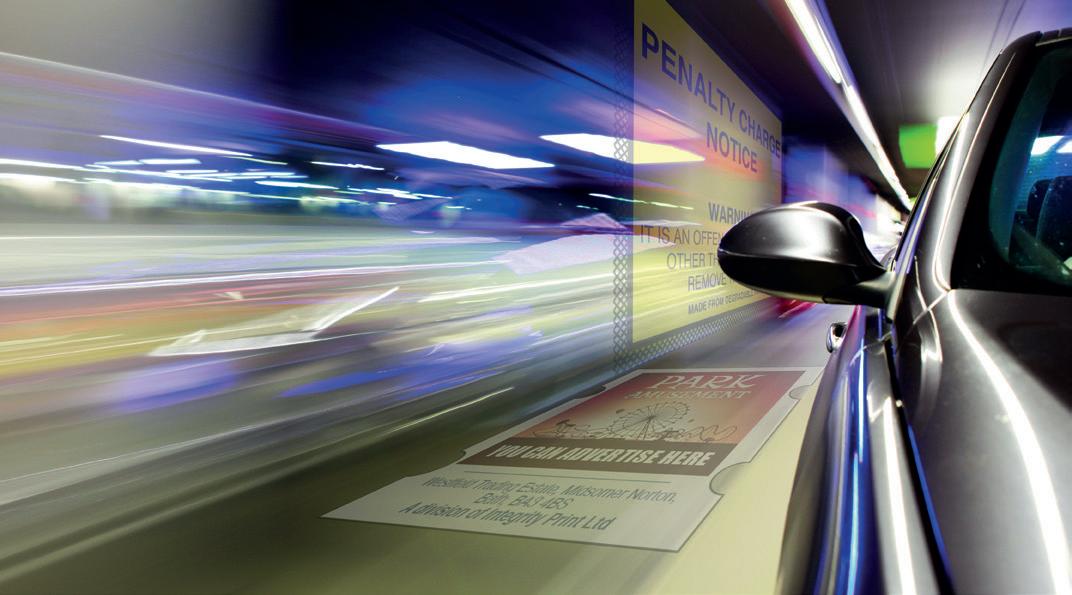
• Collabora琀ve working – joint no琀ce processing and shared enforcement.
• On and O昀 street tra�c regula琀on order wri琀ng.
• DPE and CPE feasibility studies and implementa琀on.
• Tari昀 reviews.
• DPE/CPE services speci昀ca琀on wri琀ng and tender evalua琀on.

Peter Lowe B.Eng., C.Eng., M.I.C.E., FBPA
Tel: 01492585055 or 07900264137
Email: plowe@rtaassociates.co.uk
RTA Associates Ltd www.rtaassociates.co.uk
ENFORCEMENT & DEBT RECOVERY SERVICES
For more information on our services, please contact:
Lauren Appleby (North) lappleby@newlynplc.co.uk 07931 811088
Shaun Byrne (South) sbyrne@newlynplc.co.uk 07964 764099

DOCUMENT AND STATIONERY SERVICES
www.parkingandsecuredocuments.com
PSD - incorporating The Parking Shop –is the market leader for parking related statutory document mailings and sustainable manual enforcement stationery.
We also supply line marking and signage solutions and as part of our service we offer on site surveys and reports.































